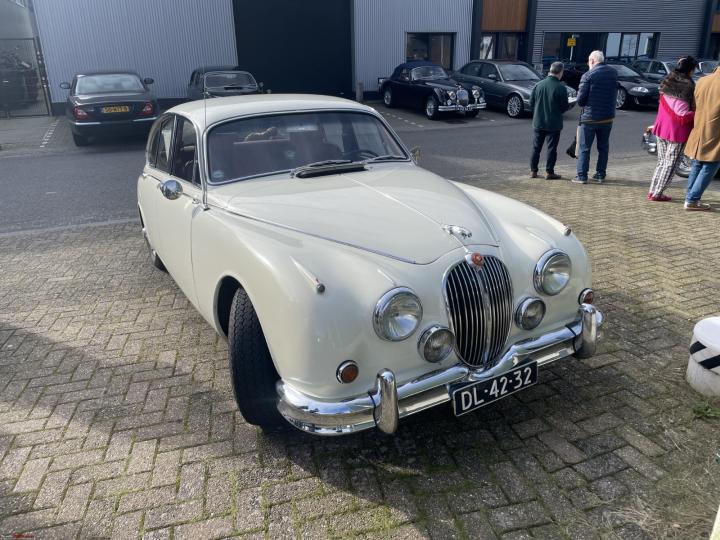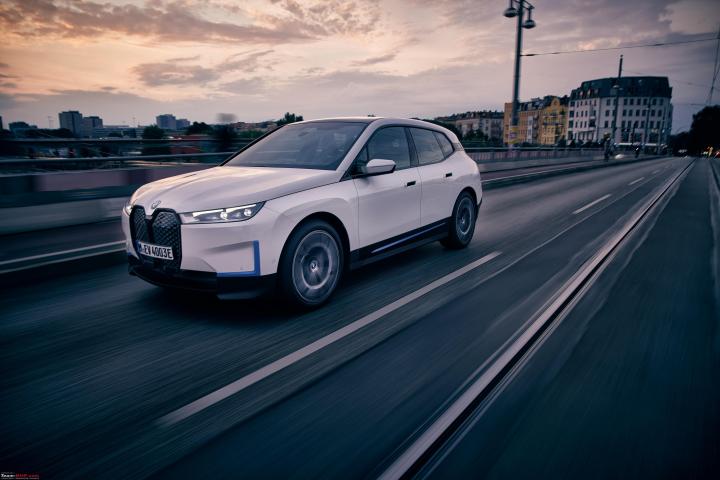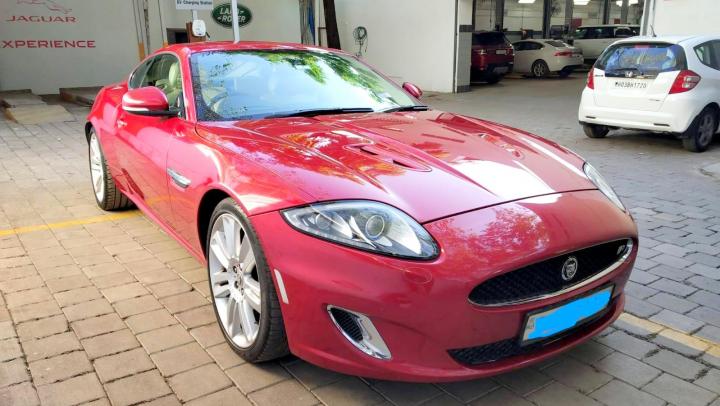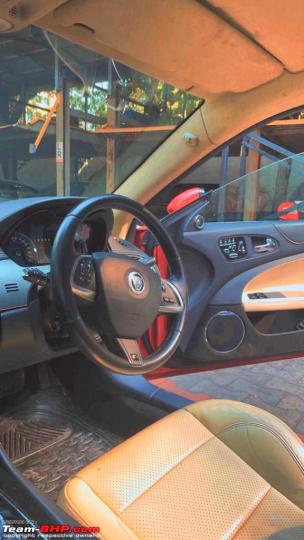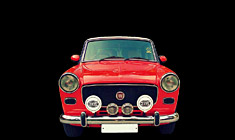News
Tata to build Jaguar Land Rover cars at Tamil Nadu factory
Some reports suggest that the new factory could be used to manufacture JLR's upcoming EVs.
Tata Motors has signed a Memorandum of Understanding (MoU) with the government of Tamil Nadu to set up a new manufacturing unit in the state. The new $1 billion facility will be used to manufacture Jaguar Land Rover models.
If the latest reports are true, then it would be the first time that JLR cars would be manufactured in India from the ground up. It is said that the factory will not only build cars for the domestic market but will also serve as an export hub.
Tata Motors acquired the British luxury brand in 2008. The company currently has factories in the UK, China, Brazil and Slovakia. JLR models sold in India are either imported as completely built units (CBUs) or assembled using CKD kits at a plant near Pune.
Tata Motors announced its plans to set up a plant in Tamil Nadu in March. However, the company did not disclose any details regarding the type of vehicles that would be manufactured there. It is still not clear as to which JLR models would be built at this facility, but some reports suggest that it is likely to be used to manufacture the brand’s upcoming EVs.
News
Attended Cars and Coffee with the Dutch Jaguar Daimler Club in my XJR
This being an official Jaguar Daimler event, the number of corduroy trousers was, as expected, unusually high.
BHPian Jeroen recently shared this with other enthusiasts.
Finally making some progress with the illustrious P1646 code. I can tell it is leaving a big mark on the Jaguar online community. People are up in arms, positions are taken, and coalitions are forged. Is the Jaguar documentation correct or not? I have had two guys suggest to replace the ECU.
Even, though I hate to admit it, the official Jaguar procedure, after I did about 14 different diagnostic tests, suggested replacing the ECU.
Those who follow my posts on TeamBHP will know that I don't take people suggesting to replace ECU seriously. Never have, never will. I spit on them because, in my, admittedly very limited, experience, it is extremely rare for any ECU to cause real issues. It is almost always something else. The real key is having a real understanding of what goes on and having the ability to perform the correct diagnostics.
With the help of the ever-pragmatic super Jaguar X308 Specialist Raymond, I might be honing in on the solution. More to come, when the problem is solved.
Just a short recap of my Coffee and Cars Morning with the Dutch Jaguar Daimler club.
The format is very simple. You rock up at some place around 10.30 on a Sunday morning. There is coffee and cake. And you talk cars with the other members. Very pleasant, very relaxing, and always interesting to meet some new folks, here some new stories, and so on. This being an official Jaguar Daimler event, the number of corduroy trousers was, as expected, unusually high.
The Jaguar Daimler Club is for all Jaguars and Daimlers, new and old alike
Nice lineup. Spot my XJR
No matter what, this is a good and impressive rear-looking car!!
In case you did not spot my XJR, here it is
Gorgeous!!
This one was a bit the odd one out. The owner had some Jags too, but decided to drive down in the Healy. He did have a very nice pair of corduroy trousers on, so it was ok.
As you would expect at these sorts of events. A lot of hoods were opened, and engines were shown off and discussed.
This is the engine of an XJ, similar to Peter's XJ. Except it's a European version and Peter's is a USA version. Which comes with a whole lot more plumbing!! Sometimes we think all this emission crap is something from the last years/decades, but Peter's XJ is well over 50 years old and had to have a bunch of stuff installed to meet Californian emission regulations!!
In all honesty, I am not sure which or what company was hosting the event. Apparently, the guy is both an appraiser as well as an agent selling and finding classic cars for people. This is sort of his shop.
Nice pleasant event.
Jeroen
Check out BHPian comments for more insights and information.
- Tags:
- Indian
- Jaguar
- Cars and Coffee
News
Complex car electronics: Solving check engine light issue on my Jaguar
Many OBD scanners will add some sort of text to the code they receive from the car. This is where our problem starts.
BHPian Jeroen recently shared this with other enthusiasts.
Finally, I managed to sort out the problem with the Jaguar. It makes for an interesting story of what kind of challenges one might encounter when diving into modern car electronics and wiring.
I thought I would spend a bit more time and provide some more detail on this particular problem. I believe it is exemplary of how these so-called "electronic" niggles might present themselves. And how difficult the troubleshooting can be. Even with many resources at hand!
Just to recap; During one of my trips to my boat, the Jag popped its CEL (Check Engine Light). The electronics on older cars, especially Jaguar can be a bit temperamental. So I carry my fancy Autel OBD scanner in the boot.
This is the so-called P-code that I found: P1646
One of the reasons older Jaguars might have some electronics issues is the quality of the wiring and various (plastic) connectors. Over time the insulation of the wiring becomes brittle and might break off, causing a ground issue. Same with the plastic connectors, they break. very often the little clip that is supposed to hold them in place simply snaps. Subsequently, the connector becomes a bit loose, water might find its way inside the pins, causing all sorts of continuity issues.
Whereas these sorts of issues are very easy to fix, finding them can be a royal PITA! Those of you who have followed this thread will have seen me fix several of these sorts of issues on the Jaguar and other cars, including my Spider.
These are not electronic faults at all. These are simple electrical faults, or mechanical faults at best. Because they can be very difficult to trace, you might come across cases where people start swapping ECUs. I have vented my opinion about swapping ECUs several times across several threads. It is important to understand there are no P-codes that suggest you need to swap an ECU. Not a single P-code, or other fault codes that have a definition SWAP ECU attached!
So swapping an ECU is always done as a last resort, but not before you have exhausted every other possibility first. Here is another thought, the Jaguar has 12 computers. When faced with engine/transmission/auto box issues, which computer are you going to replace? At least 3 or 4 of the computers are involved in the correct working of the complete power train.
Somewhere on this thread, I have shared an official Jaguar Technical bulletin on ECU swaps. Jaguar technicians swap computers and they get sent to Jaguar who checks them. The vast majority of these 'swapped' computers did not have any issues. It is a bit of sobering thought, that if, by and large, very well-trained and equipped, Jaguar Technicians incorrectly swap computers around, how the hell do mere DYI technicians trace and solve these sorts of issues?
Well, partly because our DIY time comes free, partly because we like to fiddle with our cars, partly because we are pretty much obsessed with our cars and partly because we have the internet. Now, the internet is a two-sided sword. There is a lot of technical crap out there. But if you have been part of the online Jaguar community for as long as I have, you know whom to trust. And of course, I am extremely fortunate to know my friend Raymond, probably the most knowledgeable guy on Jaguar X300/308s here in West Europe.
How is it that swapping computers sometimes does solve the problems? There are different reasons. When you pull a computer you will have to disconnect all the connectors. Depending on the car, you might have to deep dive under the dash, move wiring looms to get to it and so on. Just disconnecting a computer, and putting it back, swapped or not, might help, because disconnecting and reconnecting these electrical connectors might solve a dirt issue or a partly loose connector.
The same is true for messing about with wiring looms. It is a known troubleshooting trick. Keep tucking at wiring looms, near various connectors and so on, see what happens! It is pretty basic, but as I explained, the root cause of these so-called electronic problems is often very basic and has nothing to do with electronics as such.
Back to the problem at hand
So I had a CEL and a P-code. It is noteworthy, as you will see, that the engine did not go into reduced power mode. Almost all modern cars have something like this. When a serious problem in the Power train (engine, transmission) is detected it ensures the engine can only run at a reduced performance, so as to limit any further problems and/or damage.
Initially, I just reset the code with my Autel Scanner. Started the engine and it ran fine, CEL was out and I drove on. But after I made another stop and restarted it again the CEL and same P-1646 code popped up. That kept repeating itself. After resetting the CEL and P code would pop up after each subsequent second start-up of the engine.
I also performed a couple of hard accelerations in normal and fast mode. Timed them. My Jags still shot from 0-100 km/h in under five seconds!!
It is an important part of troubleshooting to try and observe as many irregularities in engine/transmission behaviour. That means noises, vibrations, warning lights, sequence of occurrence, under what circumstances does it happens etc.
In this case, every second start-up is relevant, because it most likely means we need to look at something that gets monitored and is allowed to show one fault during one cycle. When a modern engine is started all kinds of parameters are being monitored. Depending on which one, the computers will ignore false and or incorrect values for a certain time. Just to allow the engine to settle properly.
Once I got back home, I started to investigate properly.
The first thing we need is some basic knowledge of OBD codes and OBD scanners.
Below you see an overview/structure of the various Codes your various computers in your car can throw at you:
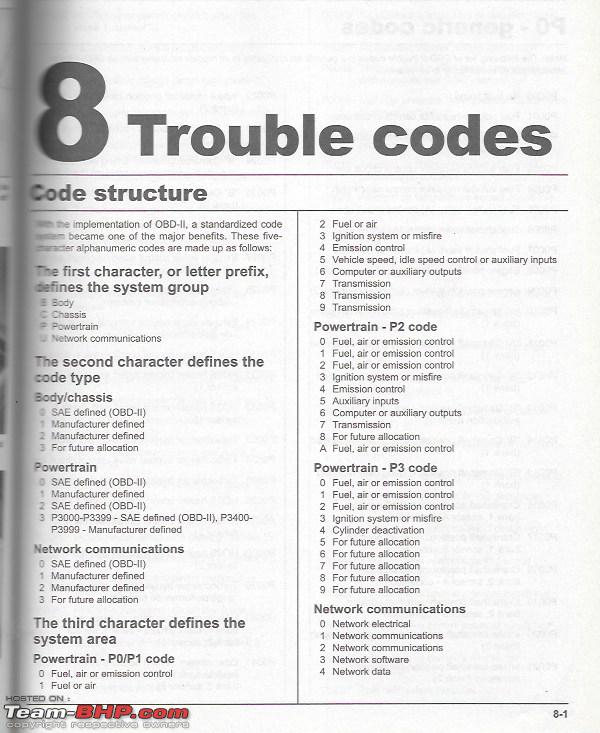
(This is a page from my Haynes OBD manual)
So we have a P1646.
- P means we have a powertrain code
- 1 means it is a manufacturer-defined code
- 4 means it is an emission control-related code
If you have followed my various posts across TeamBHP you will notice I always advise members to get their engine codes read with a scanner that can handle "manufacturer-specific codes".
Most (cheap) scanners will only read the general or SAE-defined codes).
Whether you have a cheap or expensive OBD scanner they all do the same thing. It is your car's computer(s) that sends the actual code to the scanner. So the P1646 is generated inside the Jaguar computer and sent to the OBD scanner.
Many OBD scanners will add some sort of text to the code they receive from the car. This is where our problem starts. As long as it is a generic code, so something starting with P0xx, you can probably rely on the correct text being applied to the respective code.
But when you have a manufacturer-specific code, it becomes messy very quickly. Even my, not-so-cheap Autel OBD scanners get it wrong!! And my Autel scanner has a pretty comprehensive database. As part of setting it up, you need to choose the manufacturer, model, year and VIN number. So you would think they have a pretty elaborate kind of look-up table and logic implemented!
So to recap, if you have a code, manufacturer-specific or otherwise, the code itself is likely to be correct. But you can not rely on your scanner to tell you what the fault means!
About these P1xx manufacturer codes. They are what the name suggests. Try looking up a P1xx code for say a Jaguar and a BMW. For the same code, you are likely to see completely different meanings!!
But it gets more complex. Even within one manufacturer, or worse one model the same code can have different meanings depending on certain variables. (e.g. engine type)
So whenever I pull a code from my Jaguar it is back to my office and find out what that code might mean for my car.
I do have a lot of documentation, but not all. I also check the various Jaguar forums on P-code as well. Immediately it became clear that P1646 is a contentious topic in the X300/X308 community!!
In essence, P1646 on my Jaguar, a 2002 Super Charged version, means a problem with the secondary fuel pump. On earlier and or non Supercharged models P1646 means a problem with the upstream Lambda sensor on the passenger side (bank) of the V8.
But not everybody agrees with the above. Worse. I could not find a solution to the P1646 on a supercharged Jaguar at all.
Let's have a look at what I found in my documentation:
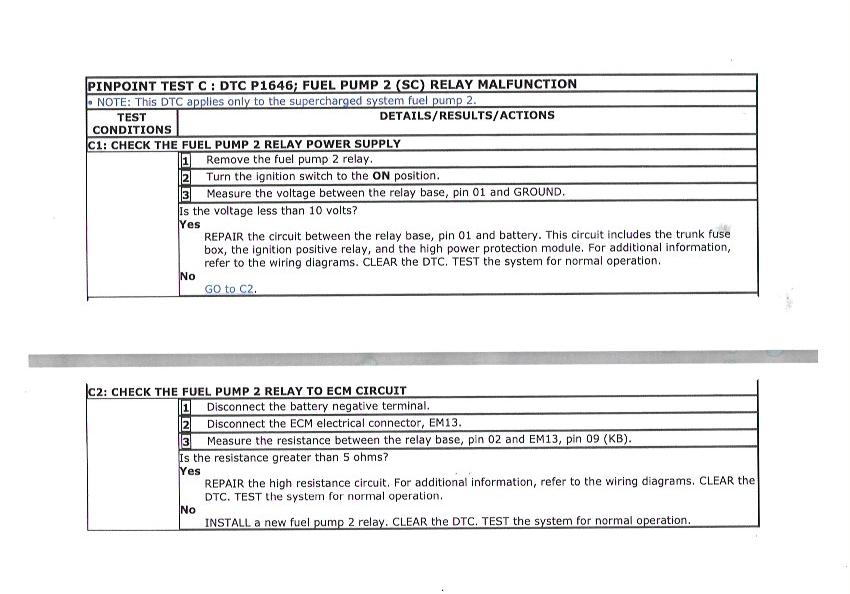
But before I start testing, I like to understand how the system I will be testing is supposed to work. That is not always that easy to figure out, but with the help of the internet, some documentation and some tests as I will show you I got a fairly good idea.
Here is the wiring diagram that shows how the two fuel pumps are operated by two relays, controlled by the EMU. Very useful when you start doing electrical troubleshooting.

The secondary fuel pump kicks in, very briefly when you turn the ignition on. It helps prime the fuel system to the correct pressure. During normal driving the secondary fuel pump does not run at all. It only kicks in at (very) high engine loads. High revs with high power.
When I began to figure out the P1646 was related to the operation of the secondary fuel pump, and a simple relay was involved. Very first thing I did was to just swap the relay with another one. Did not solve anything. I did notice that when I pulled the secondary fuel pump relay, I would get the CEL and the P1646.
So next I just went through all the various tests described above.
Which involves testing for correct voltages at various terminals and measuring for continuity (lack of resistance) in the various wires going from the Jaguars computer (EMU) and the relay. The EMU sits at the front under the hood and the relay sits in the boot.
Disconnecting the correct connector from the EMU
The relay and fuse box in the boot. Notice the thin grey wire sticking into the relay socket? I used that wire to perform the continuity (resistance) test as mentioned above under C2.
I also injected 12 V directly into the fuel pump. I could hear it turn and fuel being pumped around the tank.
After a couple of hours of fiddling, I had not found anything out of the ordinary. Time for some more road testing. My Autel OBD scanner also has a live data function. So it can scan hundreds of different sensors, and parameters all over the car. So I took the Jag for another spin.
The first thing I wanted to check is whether the secondary fuel pump really kicks in under acceleration. Look at this, sure it does!
I also checked all available parameters. Based on various discussions on the internet I was particularly interested in the operation of the lambda sensors. My car has four, two on each side of this monstrous V8. One upstream and one downstream of the catalytic converter.
I looked at all the data and compared left to right, right to left but I could not detect anything abnormal. These are heated lambda sensors. So they have a heating element as well as providing the actual O2 measurement (as a voltage)
So all my tests and measurements brought no resolution as to the cause of this P1646 and CEL. As I mentioned, I did have a CEL but not reduced performance. As I dived deeper and deeper into the Internet and my documentation that was odd. Because with P-1646 on my Supercharged Jaguar, I should have also seen "reduced performance"? Confused, I certainly was by this time.
In the end, for lack of other options, I decided I was going to take a closer look at this blasted Lambda sensor. Sure enough, when I measured the resistance of the heater circuit I found it to be infinite!
Time to call super Jaguar specialist Raymond. As always Raymond gave me a very elaborate explanation. He never uses P codes or the sort of measurements from the Jaguar documentation. He has a very advanced Jaguar-specific diagnostic system. Which will tell him, immediately what the problem is and what else to check and to replace. I would love to own one. But it cost more than my Jaguar, so I doubt I will get Mrs D to approve such an expenditure.
Based on his experience, Raymond was 100% sure it was the Lambda sensor. He replaces some 40-45 of these annually!
He told me to remove it and send an image of the connector. There are dozens of different sensors out there. But the so-called connector code tells Raymond what sensor I needed. The connector code is the shape of the connector in combination with the various notches on its edge.
Getting a Lambda sensor out of its socket can be a bit of a struggle. I was relieved to get it out fairly easily. Albeit by using one of my large spanners with a 1-meter-long extension. These things are tight!
I had to remove the air filter intake filter housing, with the air mass flow meter and tubing to the throttle body. Simple job, two bolts, five clamps on the filter and one electrical connector.
Again, one of the clamps on the filter body broke off. Did I mention the cheap quality of Jaguar plastic! JW weld to the rescue as always.
The spannering itself was not all that difficult, once the air inlet assembly was removed.
You can clearly see the Lambda sensor sticking out, just above the catalytic converter.
Here we have the old sensor on my workbench, amidst endless Jaguar documentation.
I spoke to Raymond around 1500 hours. I send him the image of the connector by 15.30. And by 1600 hours Joke, Raymond's wife had dispatched the new Lambda sensor by courier to me!! That is outstanding service!
The next day it arrived around 10.00 o'clock. All the couriers and mailmen know, if nobody answers our doorbell, check the garage!! Because I am usually in my garage.
As per my usual, checking old and new. Although, the chances of Raymond sending an incorrect part are probably close to zero, if not actually zero!!
Put the new sensor in, and took the Jaguar for a spin. I am happy to report that I have driven over 500 km with the new Lambda sensor. No CEL, no P-codes.
It still remains a mystery to me and many folks on the internet what is going on here. There is no doubt that pulling the secondary fuel pump relay triggers the CEL and P1646 on my supercharged X308. There is substantial evidence out there in the shape of many official Jaguar documents that confirm, that my car P1646 is related to the secondary fuel pump!
Even so, the root cause of the CEL and P1646 was the heater in the Lambda sensor giving out.
As always, there were some folks suggesting to swap out the ECU or rather EMU as Jaguar calls it. But to them, I say what I always say. Statistically, the chances of anything being wrong with the ECU/EMU or any computer are extremely slim at best.
My best guess is still some errors in the Jaguar documentation. One of the problems we have is that there is a lot of Jaguar documentation about it. But not all, and you never know if you have the latest revision. Even on these old cars.
Obviously, there are a few known ECU troubles on come cars. But they tend to be well-known by the respective make/model community.
I am very happy with having solved this problem. Learned a lot too.
I hope this little story might help other members too, when discussing the intricacies of troubleshooting "electronic" problems on modern cars.
Check out BHPian comments for more insights and information.
News
JLR mulls electric vehicle manufacturing in India
JLR could set up its largest manufacturing unit outside the UK at Sanand or Pune.
According to a media report, Tata-owned JLR is exploring the possibility of manufacturing electric vehicles in India. If the plan goes through, the British carmaker could set up, what would be the largest manufacturing unit of JLR outside the UK, at Sanand or Pune.
Reports suggest that JLR’s plans have gathered momentum as negotiations for the proposed Free Trade Agreement (FTA) between India and the UK reach an advanced stage. The carmaker is likely to invest billions of pounds in the new project that would include at least four models each from Tata Motors and JLR.
JLR’s future EVs will be based on the EMA architecture. EMA is a born-electric platform that was announced in 2021. It will underpin the brand’s next-generation electric SUVs, including the Velar, Evoque and Discovery Sport.
The EMA platform will be localized by Tata Motors for its Avinya range of cars, which are expected to roll out in 2026-27. JLR estimates a production volume of around 3,00,000 units, one-third of which, will be for Tata Motors, while the remaining will supply export markets.
Source: Autocar India
News
Mercedes-Benz EQE SUV vs BMW iX vs Jaguar i-Pace vs Audi Q8 e-tron
If you had to pick between these luxury electric SUVs in India, which model would it be?
BHPian Ripcord09 recently shared this with other enthusiasts.


Mercedes-Benz EQE SUV

What you'll like:
- Futuristic-looking design and styling coupled with solid CBU build quality
- Whopping 402 BHP and 858 Nm (!!) from the twin motors. 0-100 km/h in just 4.9 seconds
- Real world range of 450 – 500 km should take care of range anxiety. Adjustable regeneration helps maximise range too
- Merc’s 4MATIC all-wheel drive system coupled with wide tyres provides excellent grip
- Interior ambience makes you feel like you’ve stepped into something special. Lovely quality of materials and attention to detail
- Loaded with features such as heated / ventilated front seats with massage function, massive hyperscreen setup with 3 displays, head-up display, 15-speaker Burmester sound system, impressive ambient lighting, connected car features, transparent bonnet, and more
- Top-notch safety kit includes 9 airbags, a laundry list of safety aids, and driver assistance features like adaptive cruise control, attention assist etc.
- Zero emissions, cheap running costs & green image will appeal to a lot of people
What you won't:
- CBU pricing makes it the priciest car in its segment. On-road price crosses Rs. 1.45 crores
- Neutral handling characteristics won’t excite enthusiasts. It’s fast, but not sporty
- Low ride height for an SUV, even with the 1-inch lift from the air suspension
- Touch-type controls can take time to get used to. Physical buttons are gone! Even ORVM adjustment is touch-based & non-user-friendly
- Some ergonomic issues like the A-pillar blind spot, poor rearward visibility and placement of the buttons on the centre console
- Missing features like rear-wheel steering, rear sunshade, grab handles for rear passengers, full-size spare tyre (has a space saver tyre), etc.
- Spare tyre is placed above the boot floor and eats into luggage space. Doesn't get a frunk either
- Back seat is more suitable for 2 healthy adults and a child. Not 3 healthy adults
BMW iX
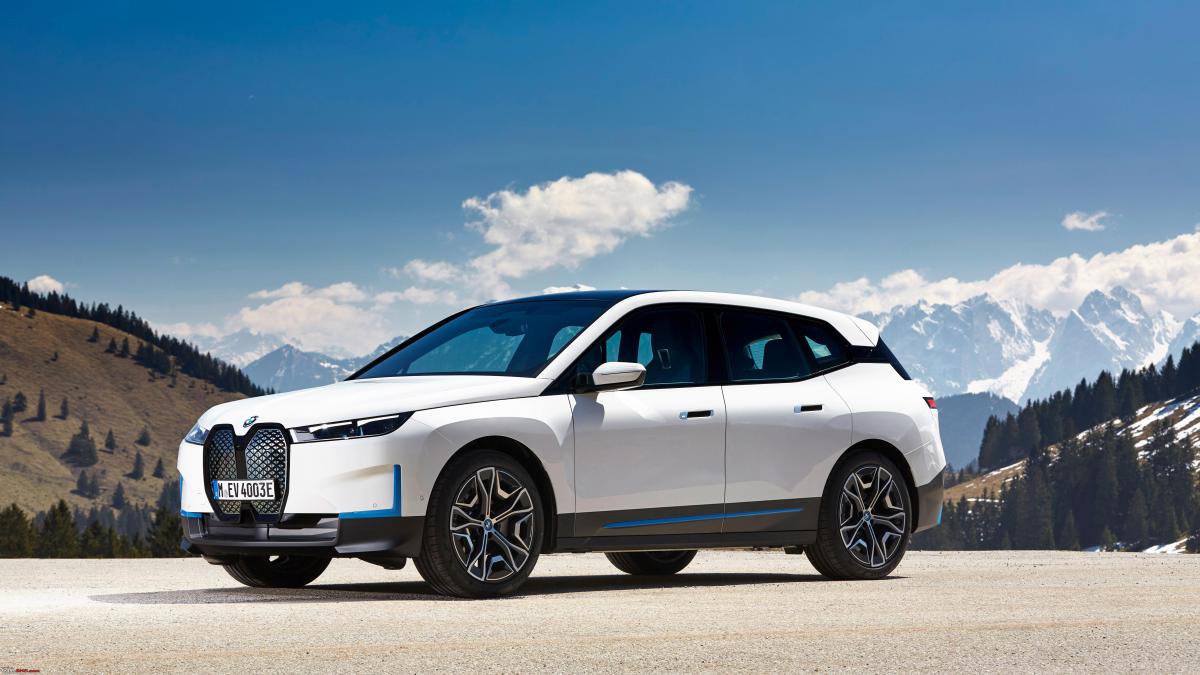
Jaguar i-Pace

Audi Q8 e-tron

What you'll like:
- Sophisticated and tech-laden EV developed without leaving any stone unturned
- Stylish & contemporary design language that lets it fit in with ICE-powered cars
- Accomplished drivetrain delivers astonishing performance. Very fast!
- Outstanding ride and handling package. Astounding levels of grip over all surfaces
- Class-leading claimed range of 582 km for the SUV and up to 600 km for the Sportback
- Trick air suspension allows you to switch between sporty dynamics and crossover-like practicality
- Well-appointed and thoughtfully designed cabin
What you won't:
- Not really a Q8. Based on the Q5 LWB mated to an EV drivetrain
- Raised floor results in lack of under-thigh support, especially for taller passengers at the back
- Interior quality is not at the same level as the Petrol Q8. Plastic trim quality below the waistline leaves a lot to be desired in this price segment
- Will be expensive, just like other EVs from the luxury marques
- Neither-here-nor-there design language of the Sportback can be polarizing
Here's what BHPian Shreyans_Jain had to say about the matter:
I don’t find any of these cars impressive enough. They are all neither here nor there kinds of vehicles. I find Mercedes’s EQ range of vehicles really crass and trashy in terms of style. All these cars are pretty weird and plasticky, a far cry from generally classy ICE Mercs. They all look and feel similar, and not in a good way. iX as well as ETron, again, the look and feel is pretty weird and way off the similarly priced ICE range. Trying too hard to be futuristic doesn’t really work. Jaguar iPace is too old to be a part of the conversation.
I find vehicles like the Volvo C40 and Kia EV6 provide a much better and well-rounded EV experience at far lower prices. The only thing these legacy manufacturers have over them is perceived badge value. This case will be further bolstered once we get the likes of Ioniq 5 N, Kia EV9 and BYD Seal in the market as well. I’d rather go for any of them, else stretch for the likes of the i7 or Porsche Taycan. Not these in-betweens.
Here's what BHPian AdiSinghV12 had to say about the matter:
I kinda agree with you, even though I find the EQE most futuristic from the inside almost like sitting in a concept car the price and exterior don’t justify the price tag but then when was the last time Mercedes Benz India was sane with the pricing this decade, on the other hand, I had the Taycan for a weekend in the Turbo avatar, the real world range I could manage was only 200 odd kms before I had to drive it on reserve back to the owner. Yes, I drove it like how a Porsche should be driven but at 200 kms real-world range, it really isn’t the best. So no matter how underwhelming in comparison to these it’d be I’d pick the Q8 e tron if I had to from above or the i7 from the two cars you chose.
Here's what BHPian GoBabyGo had to say about the matter:
Hi, I agree with you Shreyans. In October 2023, my boss picked up the Kia EV6 AWD after evaluating almost all the EVs from 48 lacs (IONIQ 5) to 90 lacs (Mercedes EQ series). My boss's family were very keen on the Volvo XC40 Recharge, but after the test drive they rejected it as it is just 2 seater and there is hardly any space in the back seat even for 2 people.
They took a few days to decide as spending 65 lacs on Kia was (& still is) difficult to convince friends, family & known. However, after 3 months of using it within NCR and taking it to their native place at Sagar in MP (near Bhopal) multiple times, they are more than happy with EV6. They are regularly getting over 500km range (100% to 15%) in NCR city drive.
Today, my boss's son asked me for the PPF on EV6, which I already recommended to him at the time of purchase, but he was hesitant due to the high cost (about 1.25 lacs), but now due to Matte colour, he is planning to get the PPF done asap.
In my view as of now, only Hyundai IONIQ 5 and Kia EV6 are the best EVs under 2 cr.
Check out BHPian comments for more insights and information.
News
Learnt a lot while fixing an old Jaguar's malfunctioned Xenon headlight
When we checked the fuse, it was fine and this was bad news because it meant there was a wiring problem somewhere else.
BHPian Jeroen recently shared this with other enthusiasts.
Does your car have Xenon lights, or would you like to understand what makes Xenon lights? Well, my spanner mate Peter's Jaguar has Xenon lights. And one of them was not working. Peter had already checked the bulb and the fuse, but they were both fine. Which usually means the so-called ballast might be short.
If you want to know a bit more about Xenon lights, have a look here.
Compared to traditional halogen lights, xenon lights are very different from halogens and can be recognised on the road thanks to the blue hue they give off. They use an electric arc between two electrodes rather than a filament to produce light and are often referred to as high-intensity discharge (HID) lights. Xenon gas is used as it helps establish an arc between the electrodes (and hence creates light) at lower temperatures, but becomes less important when the bulb is up to temperature.
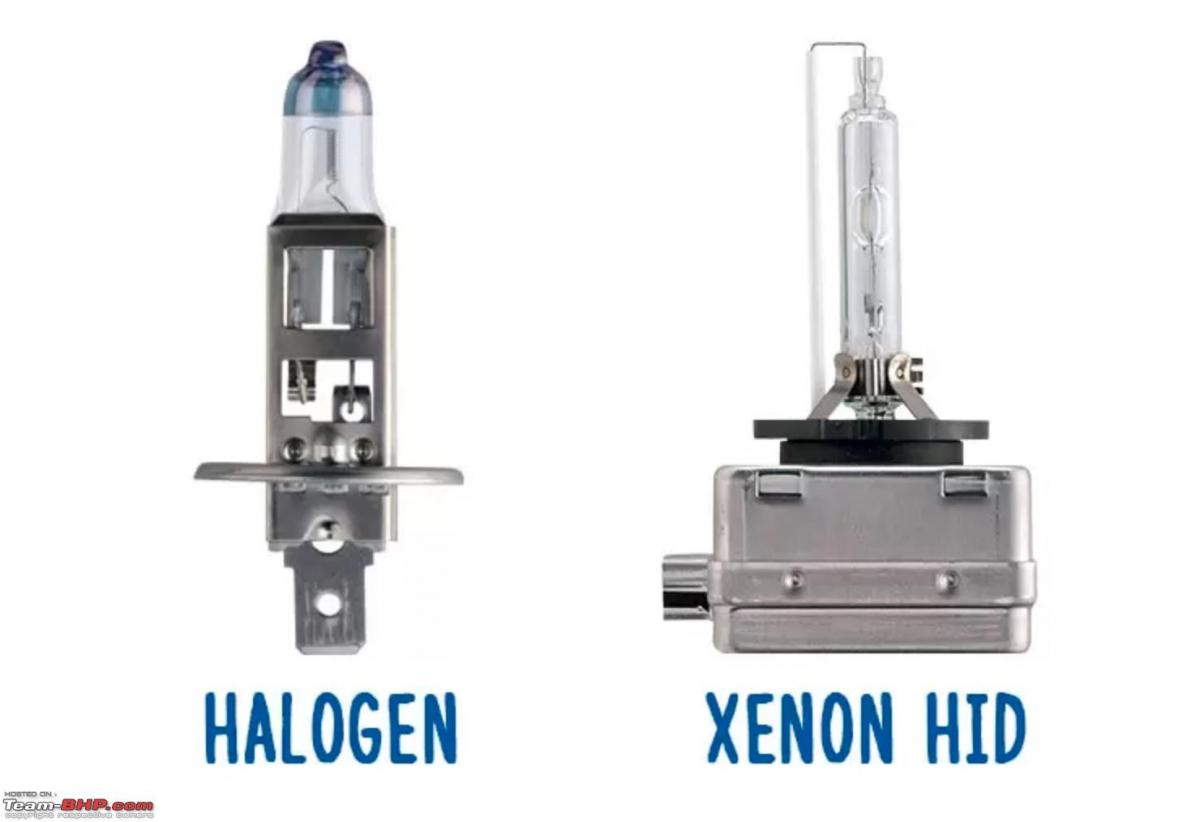
A big advantage of Xenon lights is Lifespan. Xenon bulbs can last up to 10 years, making for a good piece of mind. Brightness - As high-intensity discharge would suggest, xenon lights are brighter than their halogen counterparts.
A downside is the cost associated with it. If you are buying a used car which has xenon lights and is coming up on 10 years old, good replacement units aren’t nearly as cheap as you would hope.
It's not only that the bulb is so much more expensive, but all the other parts associated with a Xenon light are expensive too. You need the aforementioned ballast (more about that later) and the headlight unit, needs auto-height adjustment for the beams as well. (At least here in the West they do). Those bits are ridiculously expensive!
So Peter had done a bit of research trying to determine what kind of ballast he needed and where it was located. The latter was simple, underneath the light unit. Which ballast was a bit more problematic? Different sources gave different parts. The difference is that it is either a 4 or 12-pin connector. Whereas the 12-pin version is still available the 4-pin is not. Even tracing the part by VIN did not provide any further clarity. Eventually, Peter ordered a 12-pin connector from a specialised Xenos light shop in Breda. They told him if anything he could swap the 12 pins for a second-hand 4 pin they happened to have in stock as well.
So we decided to pull the headlight unit and see what was installed to start with.


Always practice removing the battery connection when working on electrical bits!

Peter had checked the Jaguar workshop manual on how to remove the headlight unit. It meant lots of plastic bits had to come off!
There is a large plastic cover plate on top of the engine/radiator. A couple of plastic plugs and off it comes. Underneath the car, we had to undo the so-called splash guard. Next, the bumper had to come off, or rather the plastic skirt.
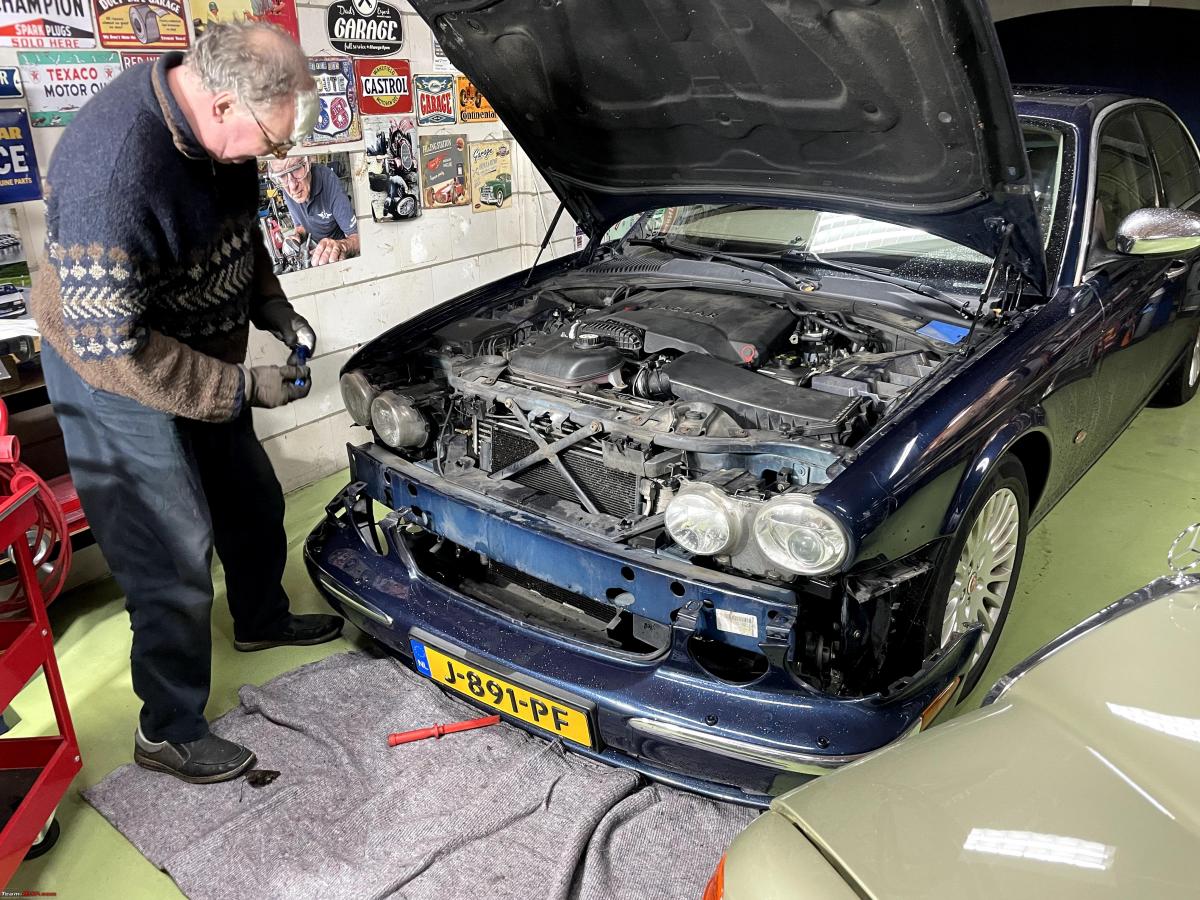
Always a bit tricky. The workshop manual tells you to just pull on the side. But a bumper is very expensive and we wanted to make sure. We found a couple of good videos on YouTube. The bumper popped off without any problems, but it did need quite a bit of force. Which is always pretty nerve-wracking! What if you break it?

The complete headlight unit was removed. Notice that connector?

I had a good look at that connector.

Similar situation on the headlight unit counterpart of the connector.
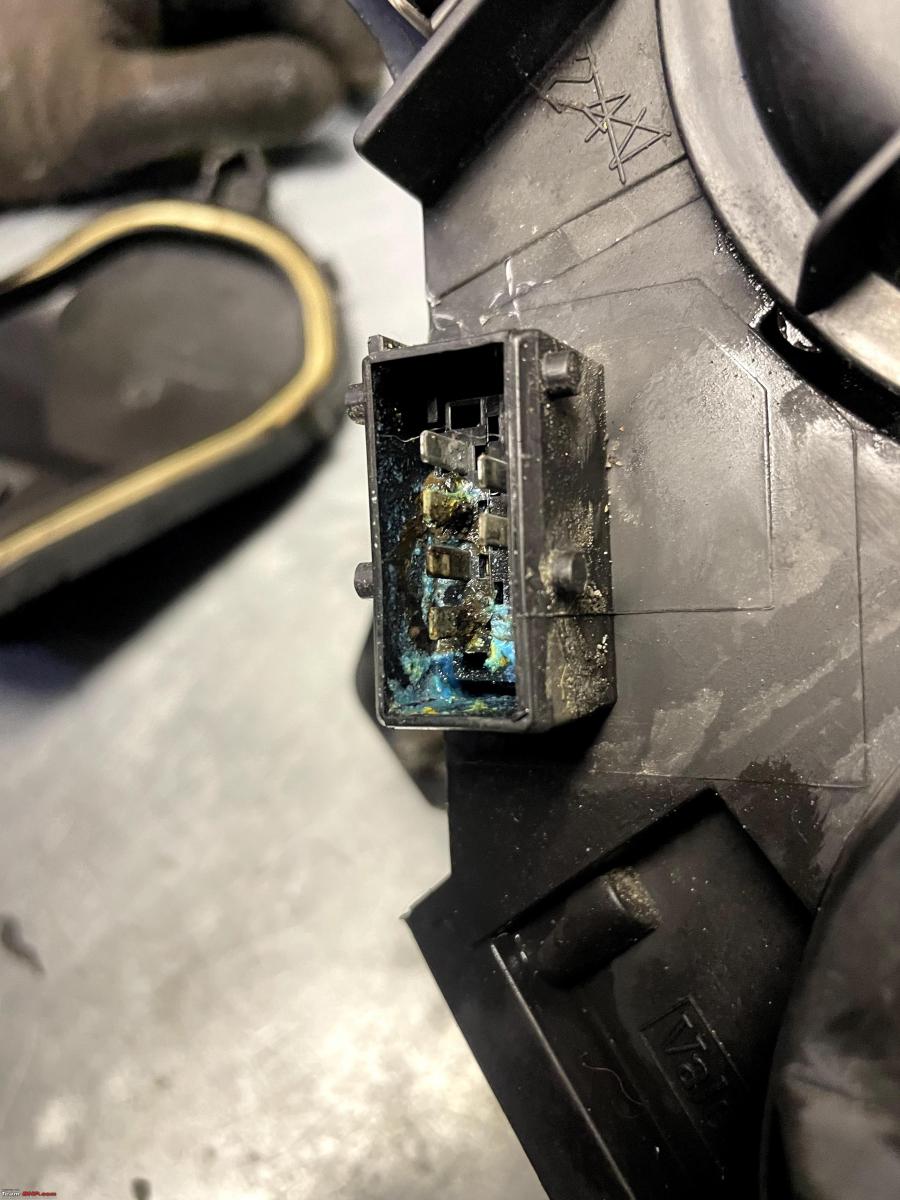
So we felt pretty sure we had found the problem. We were not sure, whether we needed a new ballast after all.
We took the ballast of the headlight unit as well.

Here you see the insight of the headlight unit and the two cables attaching to the ballast. If you look carefully you can also see part of the self-levelling adjustment mechanism.
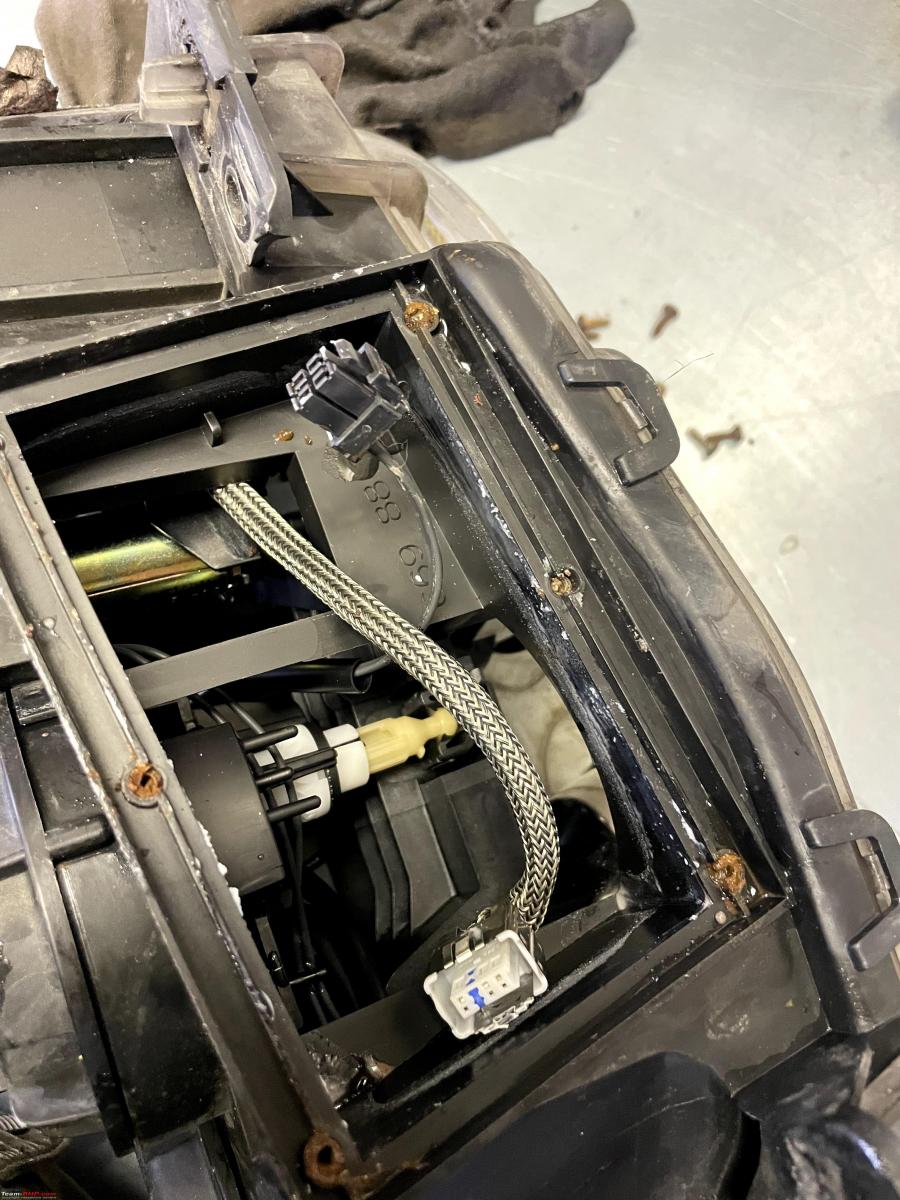
It was also clear this was a 4 pin ballast. The Ballast had some water damage as well. So we decided to hop into my Mini and drive to Breda and swap the brand new 12-pin ballast for a second-hand 4-pin ballast. Peter got two second-hand 4-pin ballast, just so he had another one in stock.
The guy from the shop told us the difference between the two versions is related to the self-levelling functioning of the headlight units. The 12-pin version has the self-levelling electronic bits built in. On the 4-pin version, self-levelling electronics are controlled via the BCM.
When we got back to my garage we replaced the ballast, connected the headlight unit to the connector in the car and turned on the light, just to see if it worked. Before putting everything back together completely. But it did not!
So we swapped the left headlight unit, to the right-hand side of the car. This would give us a clear indication of whether the problem was still within the right-hand headlight unit or the right-hand headlight wiring. Good thing we did, because the left unit did not work either when hooked up to the right side wiring.
Back to the drawing board!
The first thing we did was check the fuse again. Simple enough. Peter's Jaguar has only three (!?) fuse boxes. The owner manual will tell you which fuse box sits where and identify each fuse.
The location of the fuse box as per the manual should be under the hood.

Fuse box under the hood:

According to the manual, the right headlight is fuse F8. That is the yellow 20A fuse, the second one from the top, right-hand row.

When we checked the fuse, it was fine. Which was bad news, because it meant there was a wiring problem somewhere else. Tracing these sorts of wiring issues is usually a real PITA!
Luckily I decided just to check all fuses, for good measure. I had a good look and even before I started pulling fuses, I could see, with the fuse still in place, a problem with the 20A fuse in the second row from the right, bottom position. F10. It had popped!!

As you can see in the owner manual, F10 is supposed to be the horn (claxon) and it is also supposed to be a different rating. Nevertheless, we put a new 20A fuse in, hooked up the right-hand headlight unit and presto. Bright Light!!

So we felt confident we had found the problem and fixed it, so we put both headlights back in and started bolting everything back on.

Peter doing the finishing touches on his car.

Peter did some checking afterwards in the full workshop manual and came up with these drawings. On the 2005 version, the fuse for the right main headlight is F8 (and F9 for the left unit)

However, for the 2006 version, the right main headlight fuse is F10!
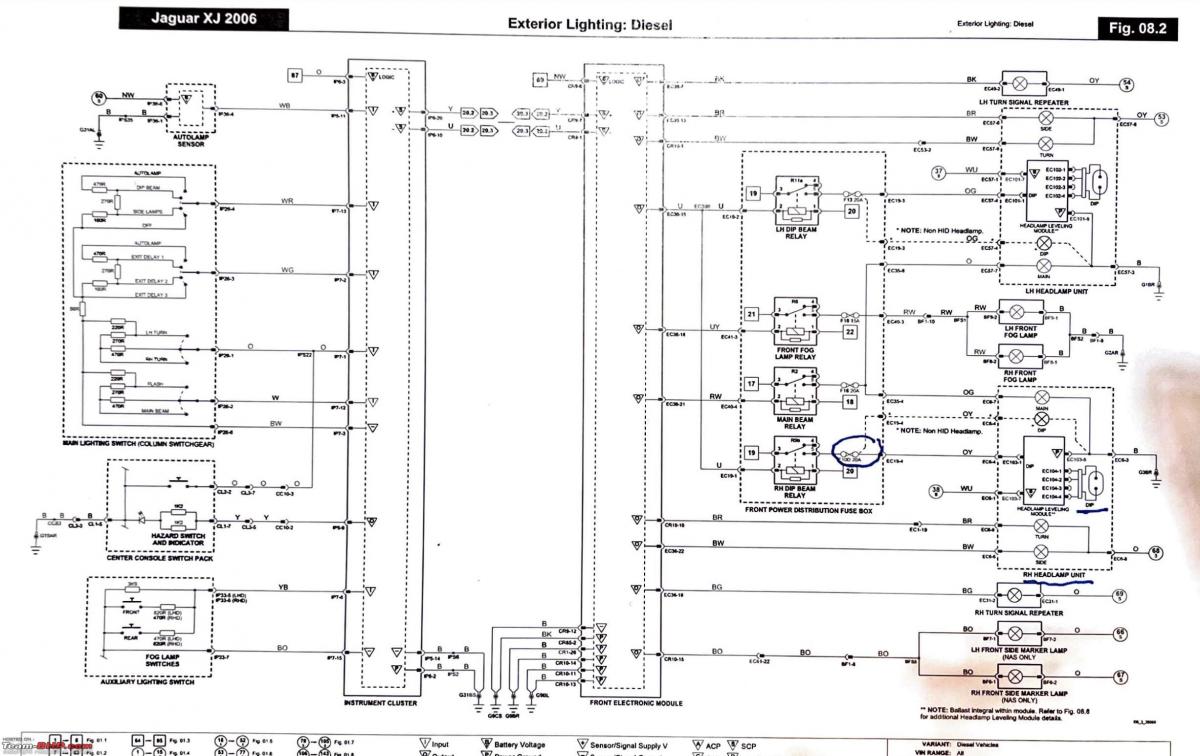
So it appears the owner manual of Peter Jaguar is a 2005 version and not a 2006 version!! Peter bought this 2006 Jaguar second-hand. Jaguars come with a lot of documentation. The complete set was with the car, brand new. So we felt, the dealer probably ordered a new documentation set as the old one had gone missing. Apparently, lots of cars get traded in, without the car documentation.
The root cause of all the problems was probably water ingress in the connector. I have come across many corroded connectors during many years of spannering, but this one was particularly bad. There was some evidence of soot even. So it probably short-circuited, which caused the fuse to pop. There was also water inside the headlight unit.
All in all, quite an interesting job. Learned a lot. Check the documentation of your car for the correct year/version!
Check out BHPian comments for more insights and information.
- Tags:
- Indian
- Jaguar
- Headlights
- car repair
- DIY
News
Fixing my Jaguar's electrical antenna: One of the coolest car gadgets
When you switch on the audio system the antenna will extend itself and when you switch the audio system off, it will retract.
BHPian Jeroen recently shared this with other enthusiasts.
Yesterday I worked on the electrical antenna of the Jaguar. Just about all modern cars have a built-in audio system. These days the antenna's are built into the window, or carefully hidden as shark fins, or at worst a little stub on your car roof.
But there was a time when cars had proper antennas that had to be extended. The plebs did this manually. You had to get out of your car and pull the antenna out. Us Jaaaag owners have an electric antenna, so you don't need to get out of your car and mingle with the plebs. You just stay in the comfort of your car. When you switch on the audio system the antenna will extend itself and when you switch the audio system off, it will retract.
Joking aside, I think electrical antennas are one of the coolest gadgets on a car. I also installed one on my Mercedes W123. Many of our younger members will never have done this, but in the olden days, installing a radio, speakers and antenna was par for the course for any car owner. Cars did not have built-in radios, let alone audio systems in those days. You had to visit specialised Car Radio Shops. They would have hundreds of different radios, speakers and accessories on display. Very few of these shops exist today.
When you sold your car, it was not uncommon to remove your radio and build it back into the next car you bought!! How times have changed?
So working on antennae and antenna wiring is something from the past for most! But I enjoy it.
When you have a car with an electric antenna at some point in time it will fail. The antenna mast is moved utilizing a plastic/nylon-toothed belt that is driven by a little motor and some clever gears. Replacing the mast is usually very easy. But in my case, I could not extract the antenna at all, so I took the whole antenna motor assembly out of the Jag. Very easy, two little bolts, two connectors.

Let's open it up and see what's causing the problems. cover removed. You can see the little electric motor that drives several gears and you can see the spool into which the toothed belt is wound.

I took things apart a little further and the problem became obvious. The toothed belt had snapped! Usually the tooth, over time, gets stripped and the mast won't extend anymore. This is a little more severe. But the solution is still the same, replace the antenna mast.
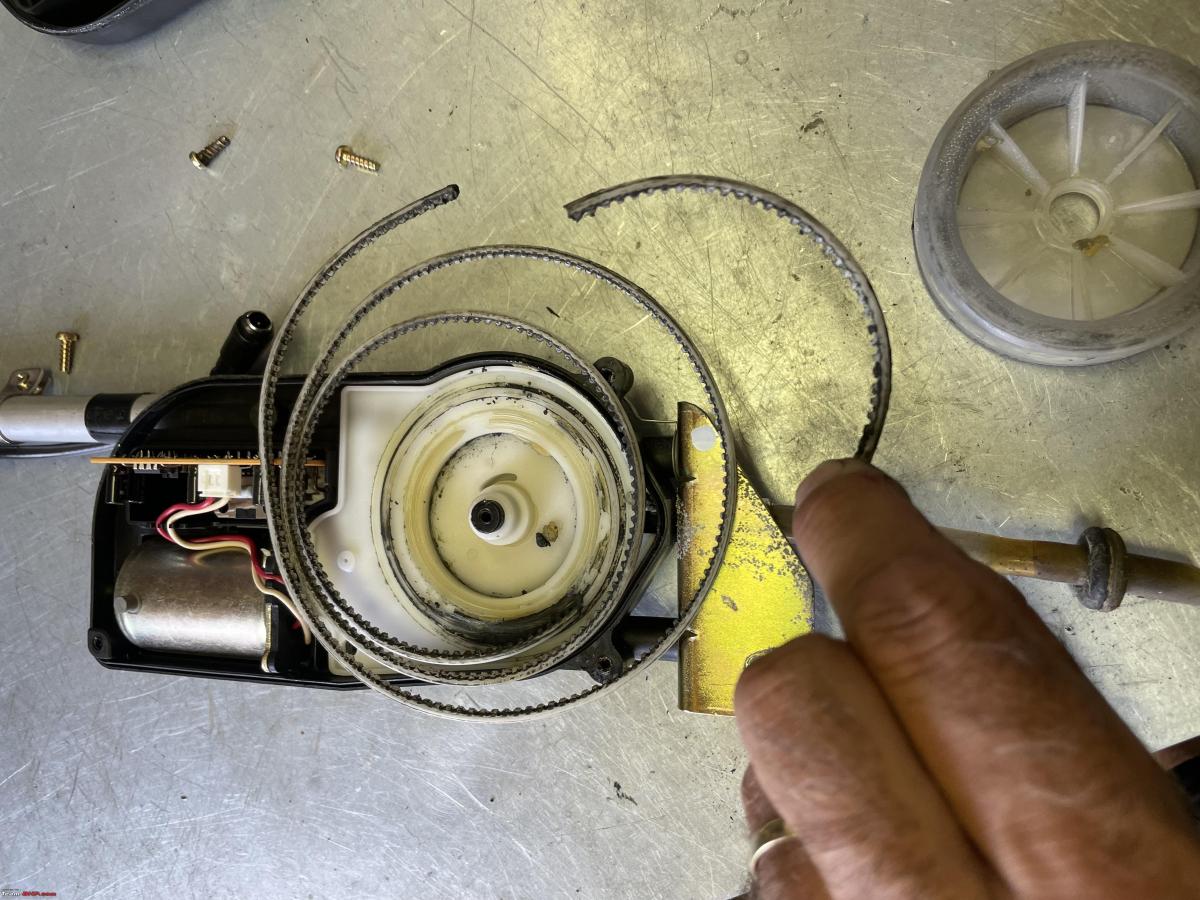
Everything apart is ready to be cleaned.
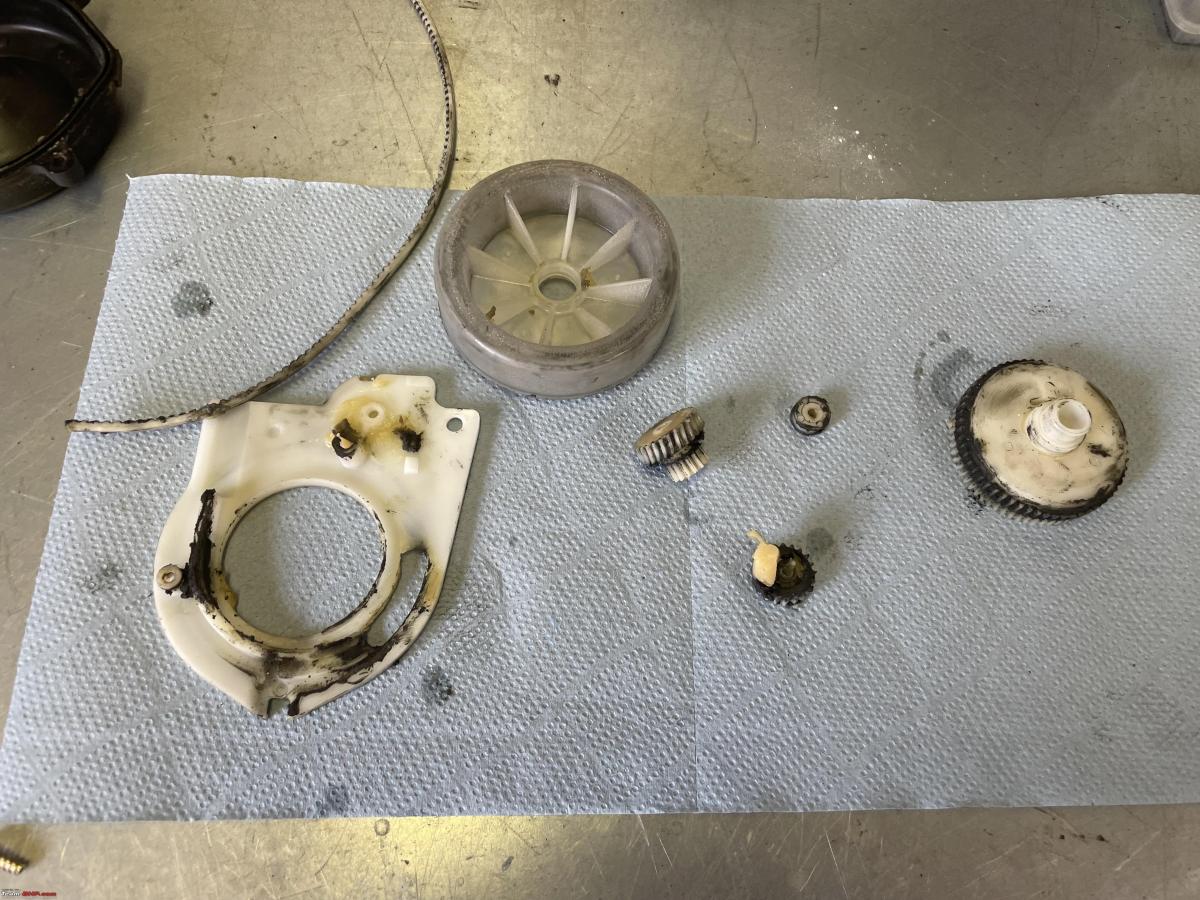
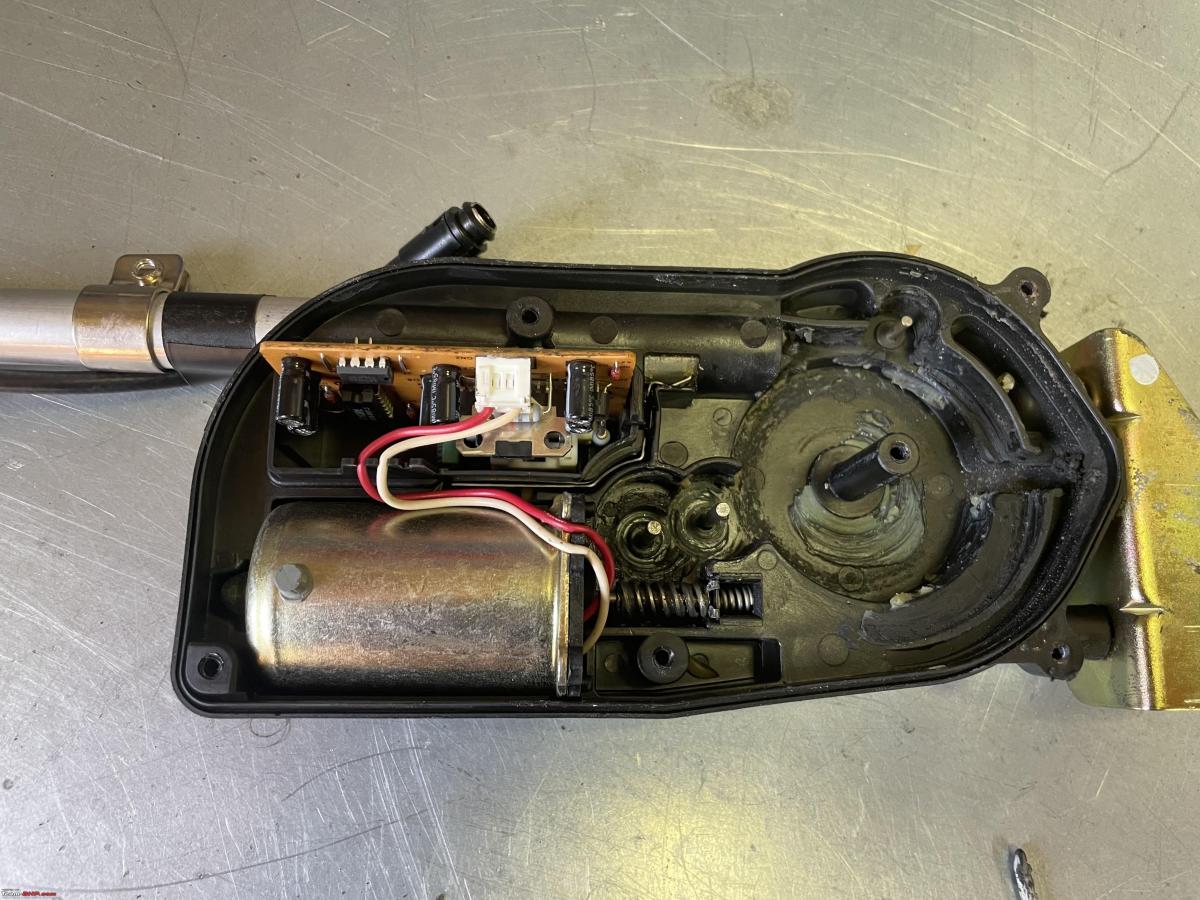
I called my Jaguar specialist friend Raymond and he had antenna masts in stock. I called him at 15.00 hours and asked him to send me one. Ten minutes later his wife Joke called me back, to confirm our address. The next morning I had a new Antenna mast!! Excellent service. Here you see the new antenna mast with a few other parts you will see me use later on as well.

As so often with these little jobs, cleaning everything is the most labour-intensive. It took me about an hour to get rid of all the old grease. I used different de-greasers, soapy water and lots of paper towels. All ready for re-assembly.

I packed all the gear with my usual, general-purpose, white lithium grease. I find this stuff works great on many different applications.
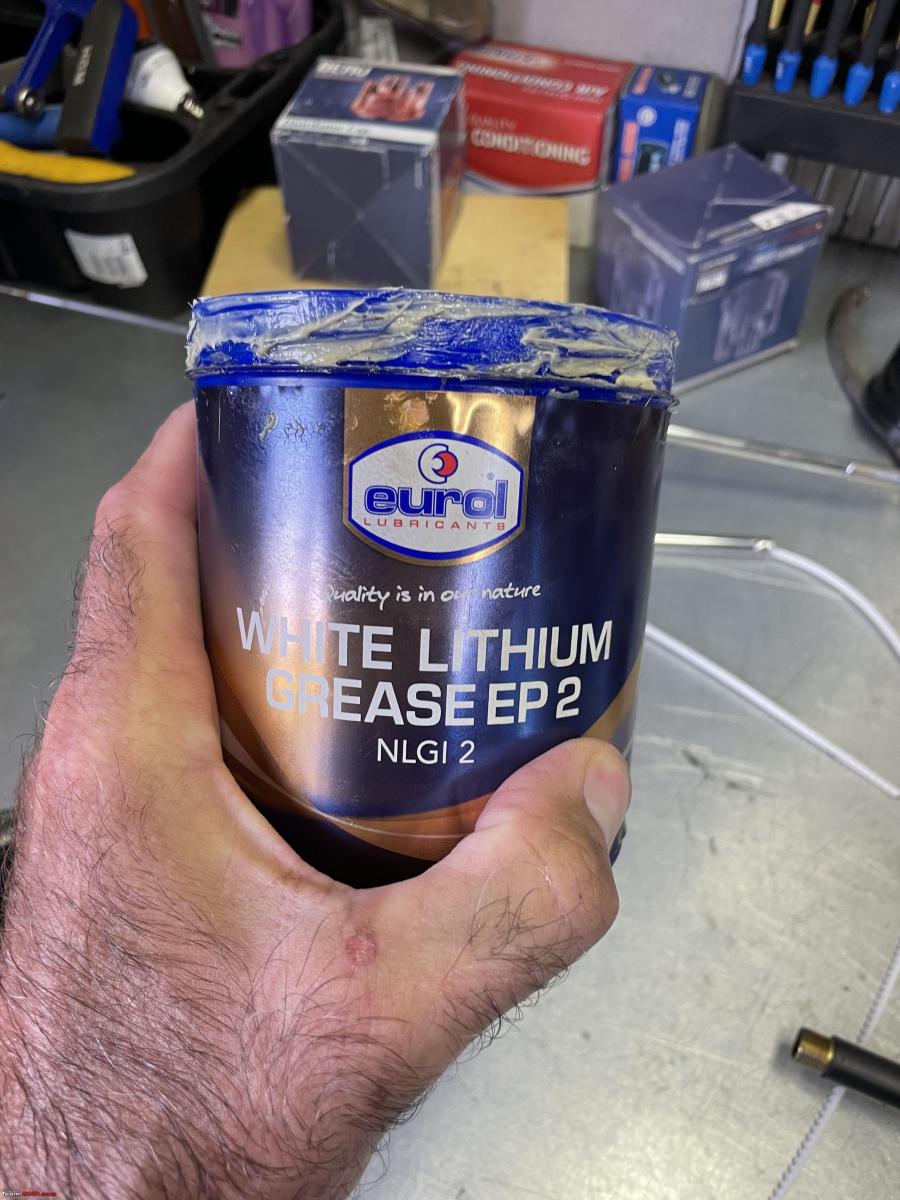
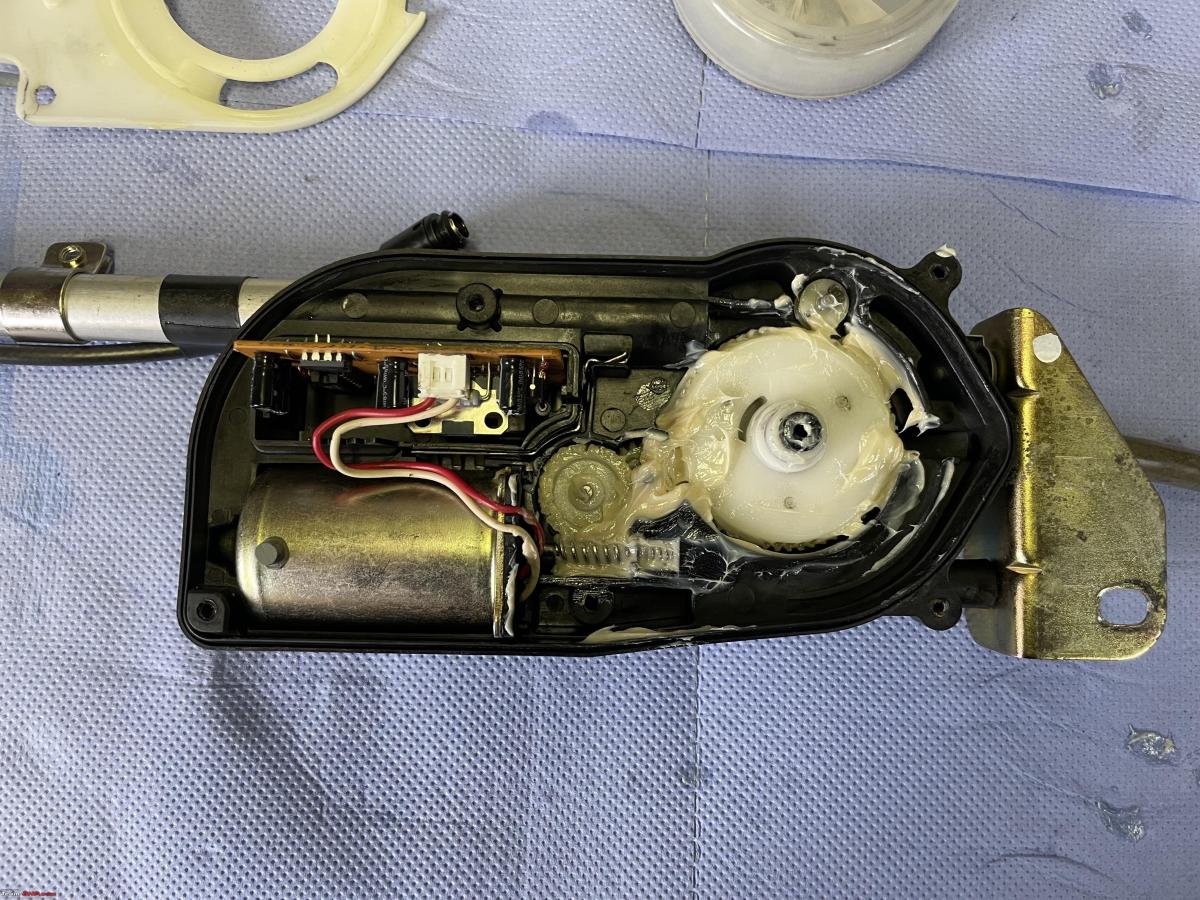
Putting it all back together is very straightforward


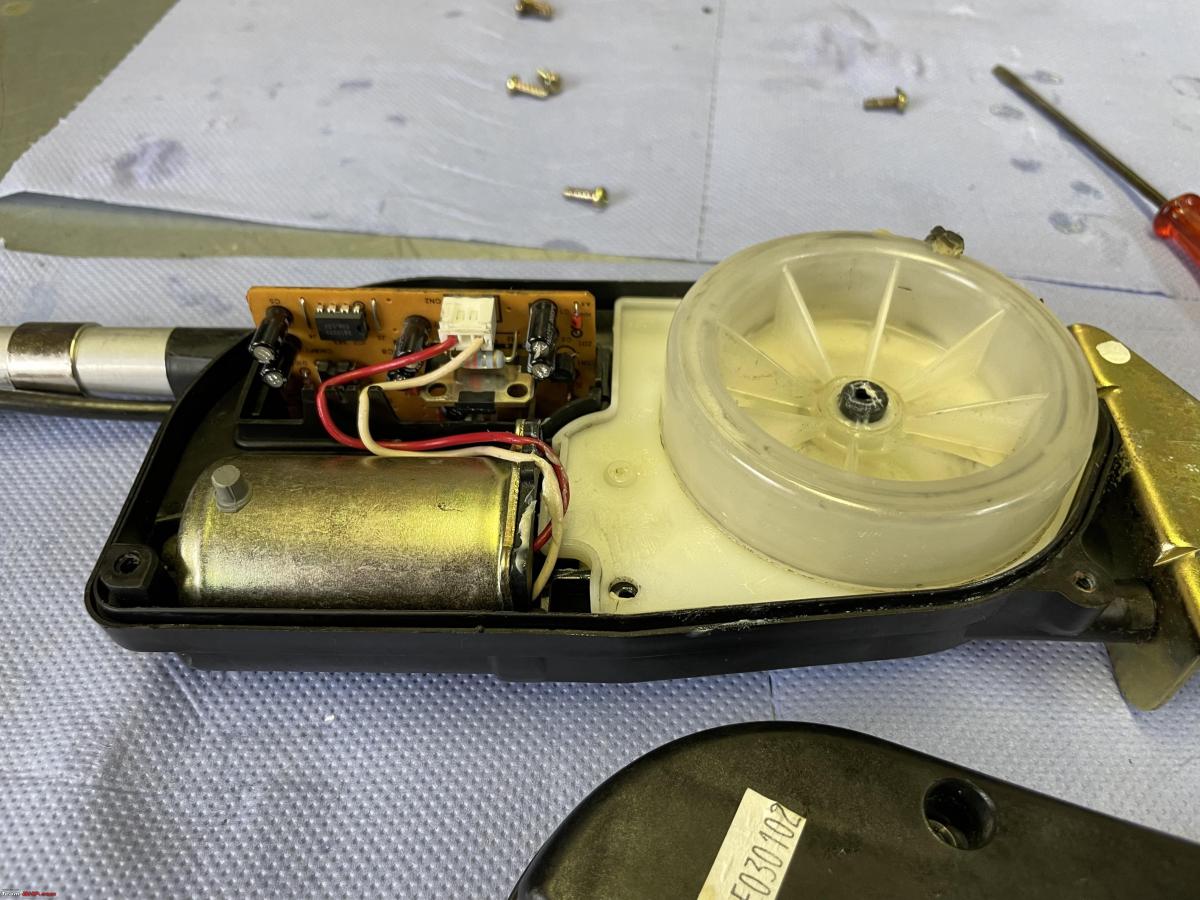
All done, ready to go back into the Jaaag.
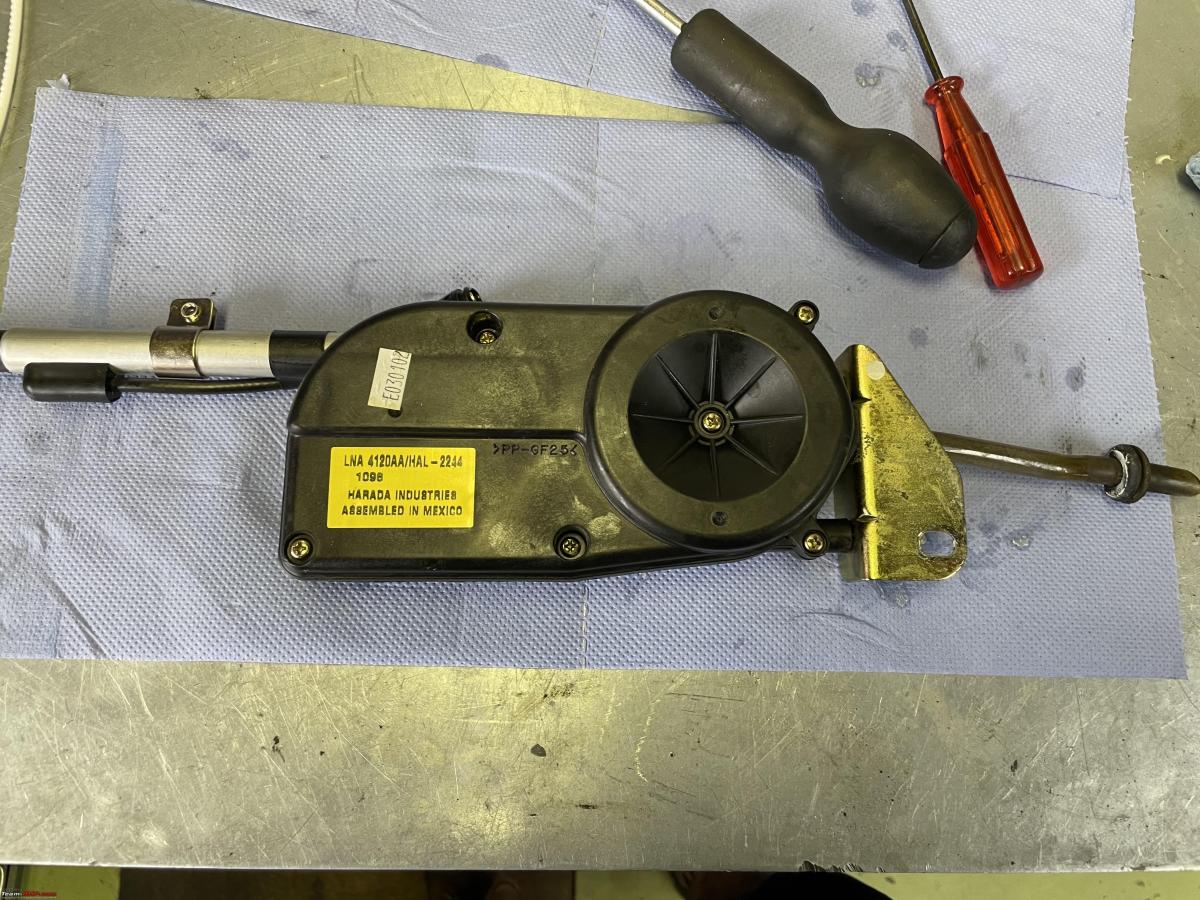
Mounted back into the boot. To get access to the antenna motor assembly you just need to remove some trim. Very easy.

To get the new antenna mast installed, I used the same procedure as always. You let the antenna motor pull in the toothed belt. So you just feed the belt into the top of the antenna tube. You do need to ensure you have the belt in the correction orientation. It can only go in one way. In the case of the Jaaag, that means the tooth needs to face outward. (Look closely at the previous image and you can see how this is the correct orientation as the toothed belt comes down the antenna tube and is fed into the storage spool and gear naturally.

All you do is switch on the audio system, which means it signals to the antenna motor to extend fully. So you hear the motor whirring, but nothing happens as there is no antenna yet. Next, you switch off the audio and push the toothed belt into the antenna tube, once the gear engages the toothed belt it will pull in the complete antenna mast! Very easy, very simple.
However, the base of the antenna mast would not go in. It appeared too big. Very strange, so I took the antenna motor out once again and did some measurements on the old and the new antenna. This little flange at the bottom of the antenna is pretty crucial. There is a locking nut on top of the antenna tube that holds the mast in place. So the flange needs to be small enough to slide up and down the tube, but also large enough to catch on the locking nut.
The flange on the old antenna: is 9.63mm

The flange on the new antenna: is 9.84mm

The inside diameter of the tube: is 9.67mm
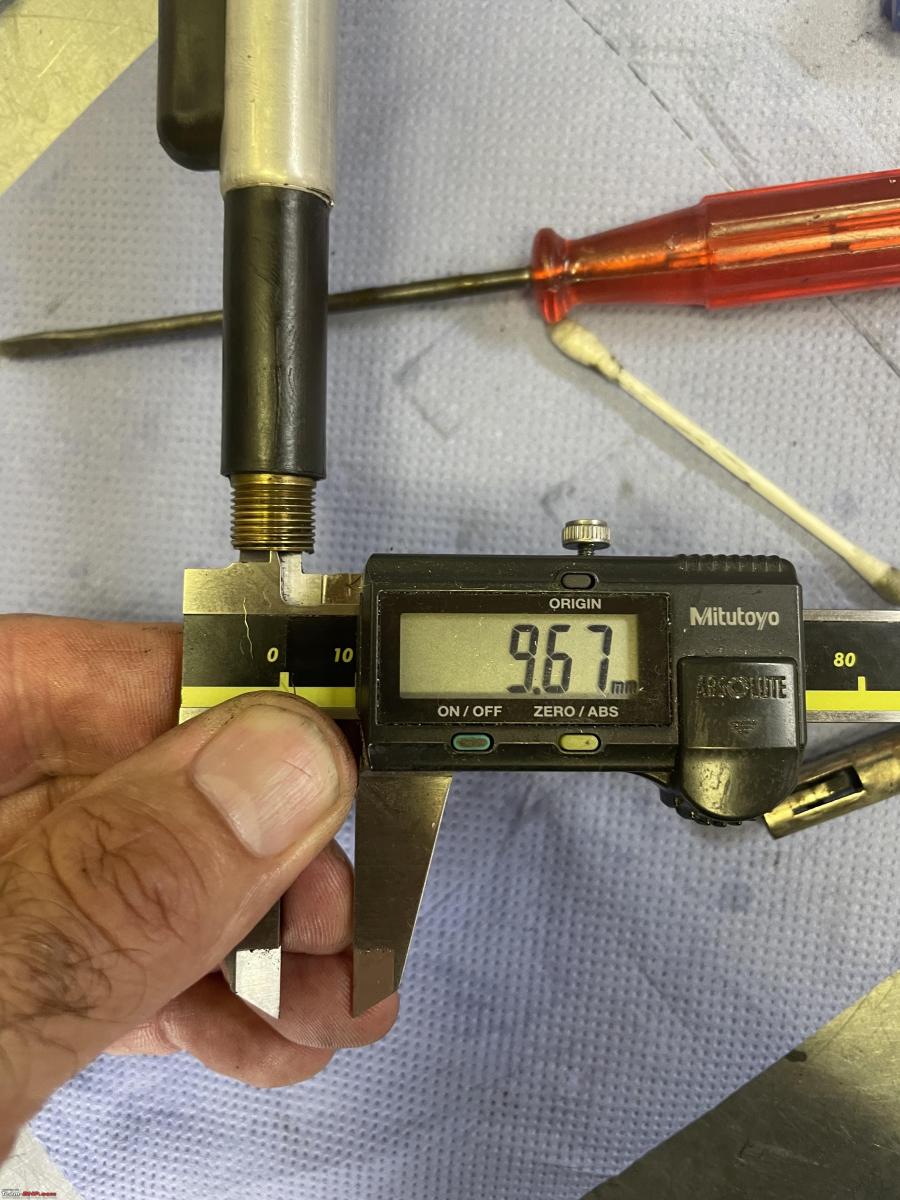
So this was never going to fit. Only 0.2mm but still! I took the antenna to my grinding wheel and ever so slightly took off a tiny bit till it just fitted into the tube.
Working!!
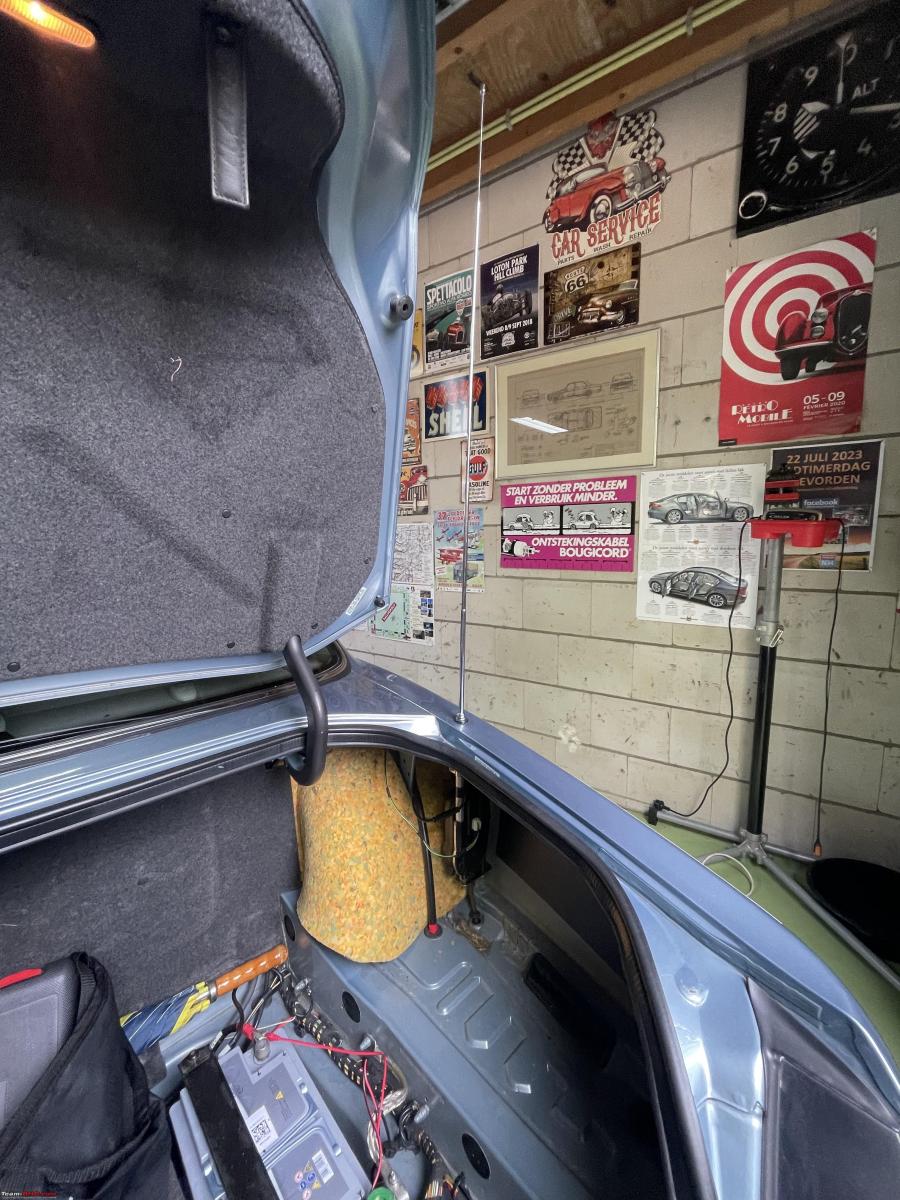
As I was working on this antenna job I decided to tackle another little job I had wanted to do ever since I got this car, but somehow never got around to it.
The electric antenna extends as soon as you switch on the audio system. But the audio system has also a multi-CD player attached, it has a cassette deck and I have installed an FM modulator so I can stream my music from an iPod and or iPhone. Only the radio requires the antenna to be extended. But it is always extended as soon as you switch on the Audio system. Very annoying, so I decided I wanted to have a manual override. Which means installing a simple on/off switch between the audio system and the antenna motor.
Time to break out the electrical diagrams:

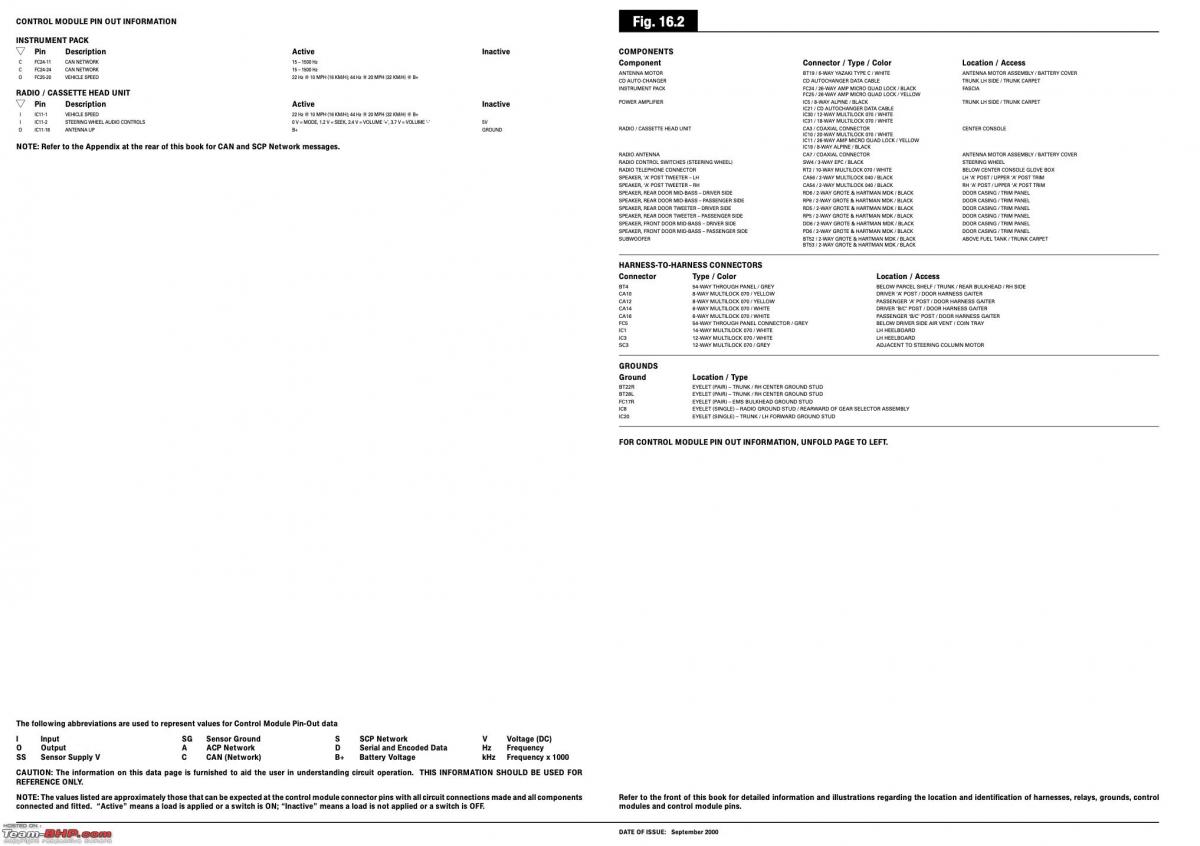
I wanted to install a little switch in a very unobtrusive way. Because I like to keep my cars as original as I can. So when I do the odd little modification, it has to be out of sight and very easy to put back to the original as well.
Based on the diagram I figured the easiest way was to pick up the signal wire from the connector against the left heelboard. That would also be close to the centre console. So I could run a wire from that connector back into the centre console storage compartment and into the ashtray, where I could mount a little switch.
See from above. The ashtray is just in front of the centre console storage compartment.

This Jaaag is chock full of electrical and electronic stuff. Under the left and right heel boards are a bunch of fuse boxes, relays and a massive amount of wiring. I lifted the rear seat to get better access.

The first thing was to run a new cable from underneath the ashtray to the connector on the left heel board. Of course, that cable needs to be out of the side, so it has to go underneath the carpet. I tried several devices to get the cable through.

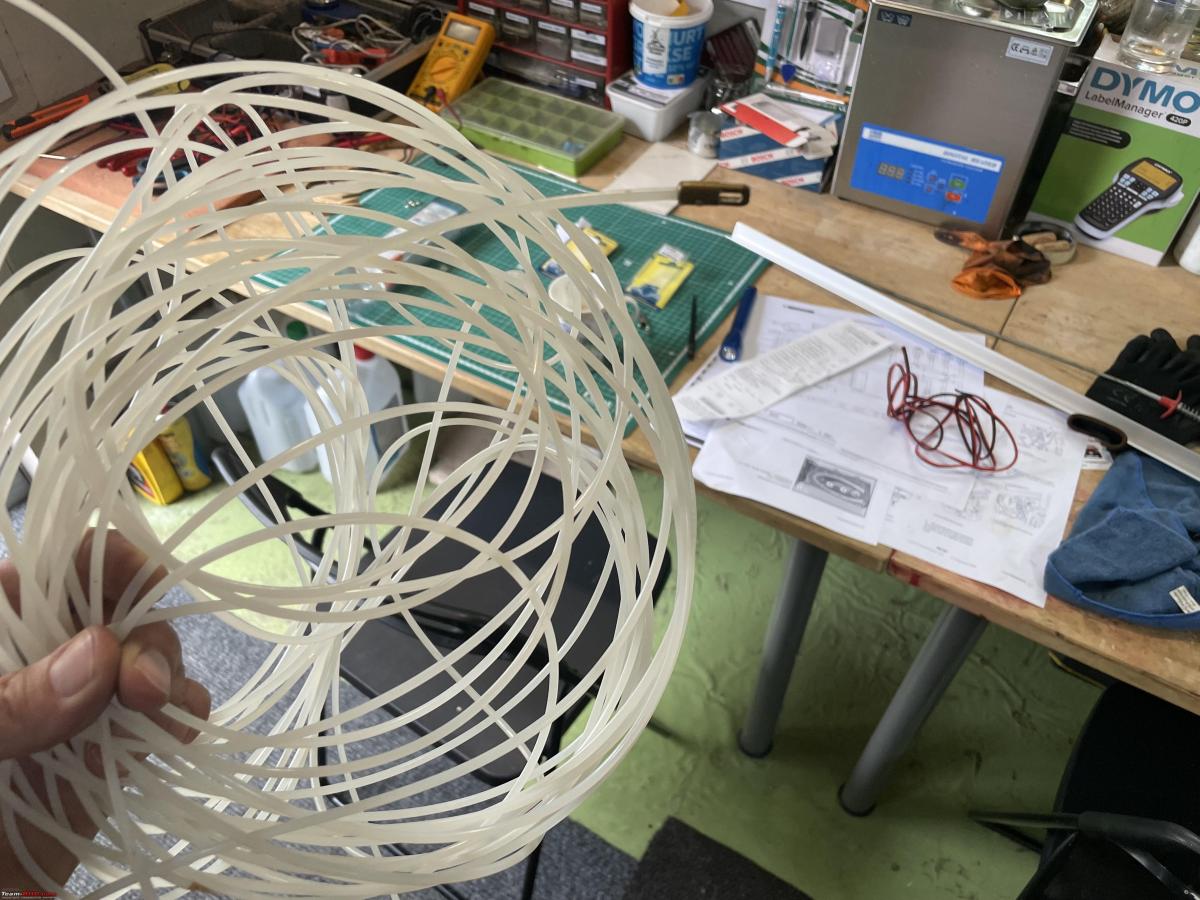
Part of the challenge is that Jaguar installs the carpet and the wire looms very tightly. There is little room to start with. Also, you want to be a little careful poking around 20-year-old wiring. These Jaaags are known for having poor-quality wiring, it gets very brittle over time.
In the end, I got myself a one-meter long, 15mm wide very flat piece of plastic. Rounded off one side and drilled a hole into it. Works very well getting it underneath carpets and past wire looms.
Goes in here

Wiggle, wiggle, push a bit, some more wiggling and out it comes on the other end!
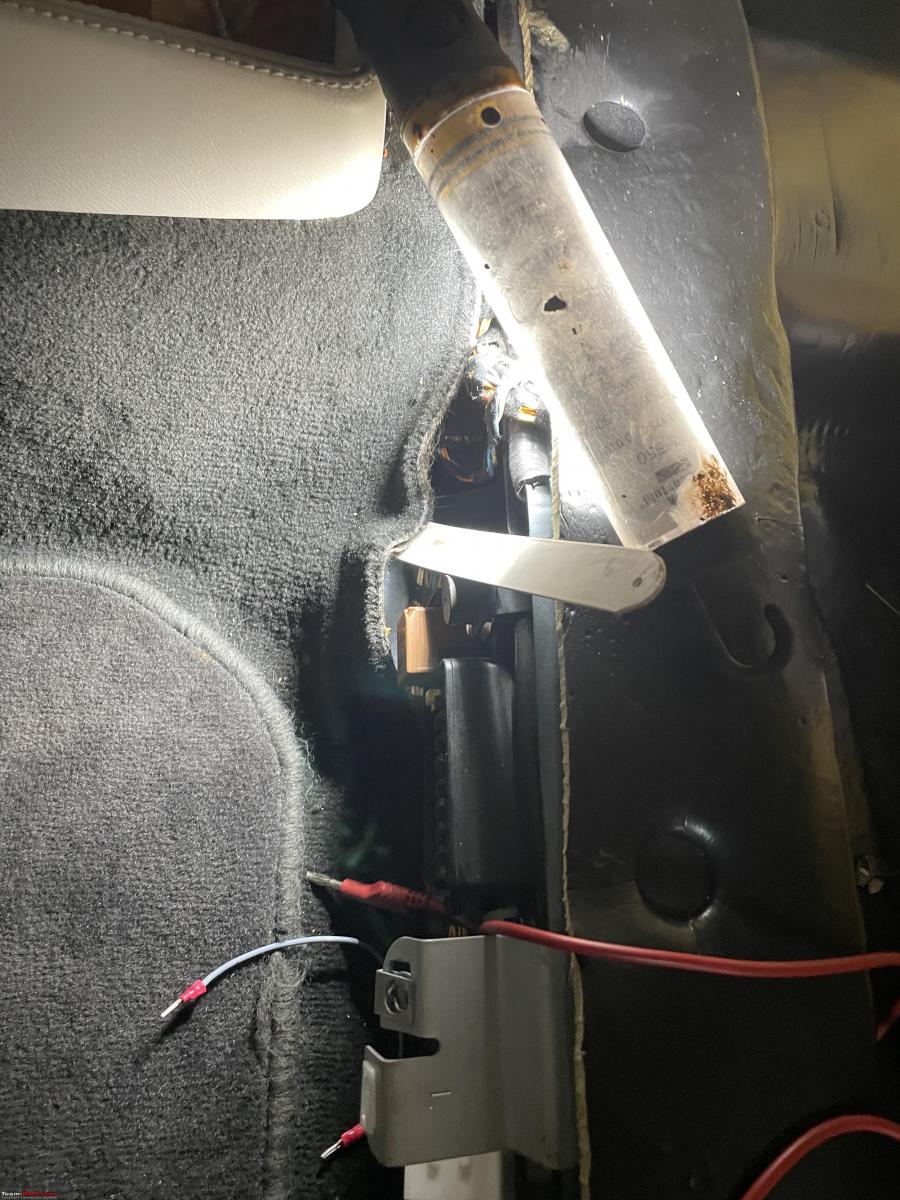
Attach the cable
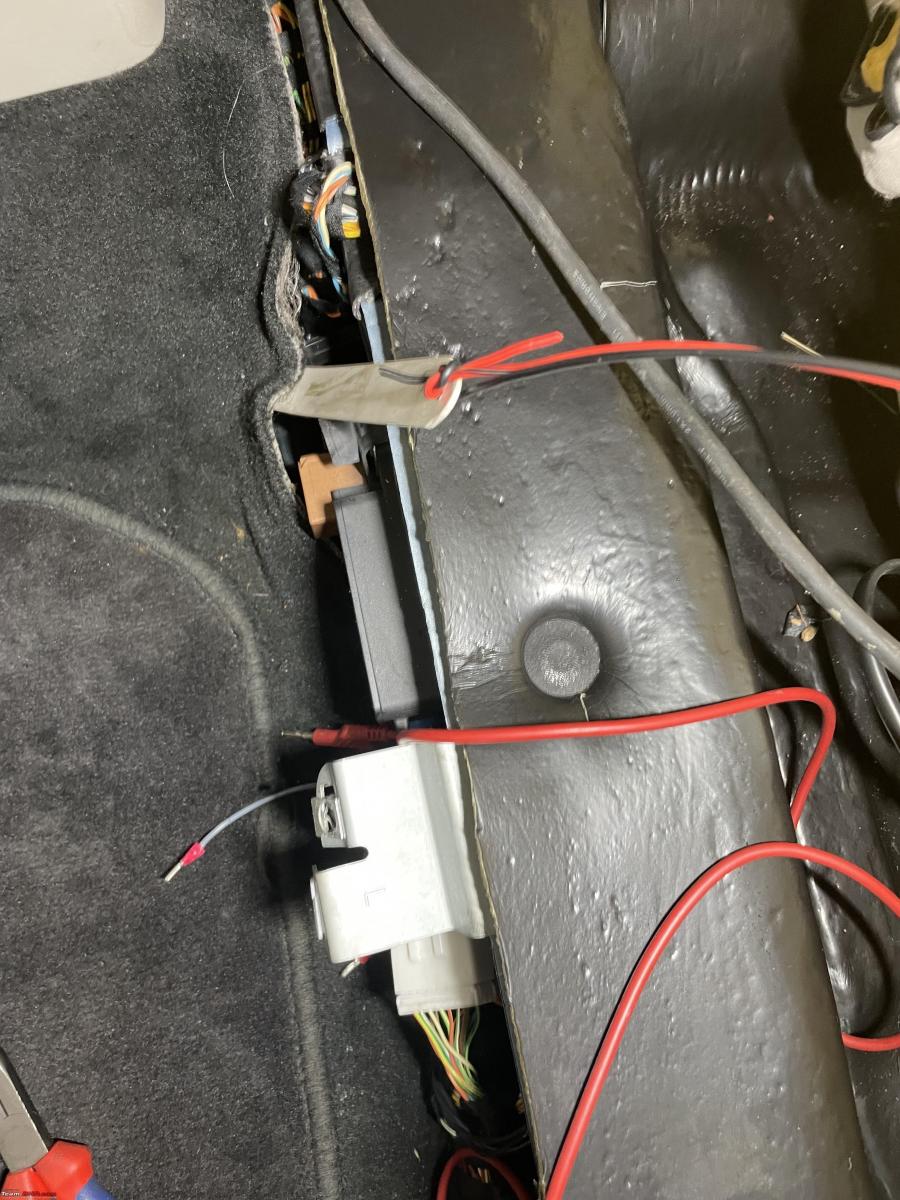
Pull back and voila: one new cable installed out of sight!

Continue reading about Jeroen's DIY experience for BHPian comments, insights and more information.
News
Trying to fire up a 50-yr-old Jaguar after over 4 years of hibernation
We could hear the fuel pump starting up but then the fuel spewed out everywhere from the front carburettor.
BHPian Jeroen recently shared this with other enthusiasts.
Yesterday I drove over to my spanner mate Peter, with two carburettors and some tools in the boot!
Time to put these things back on and start up this 50-year-old Jaguar.
We completed the last few jobs on the carburettors on Peter’s workbench.
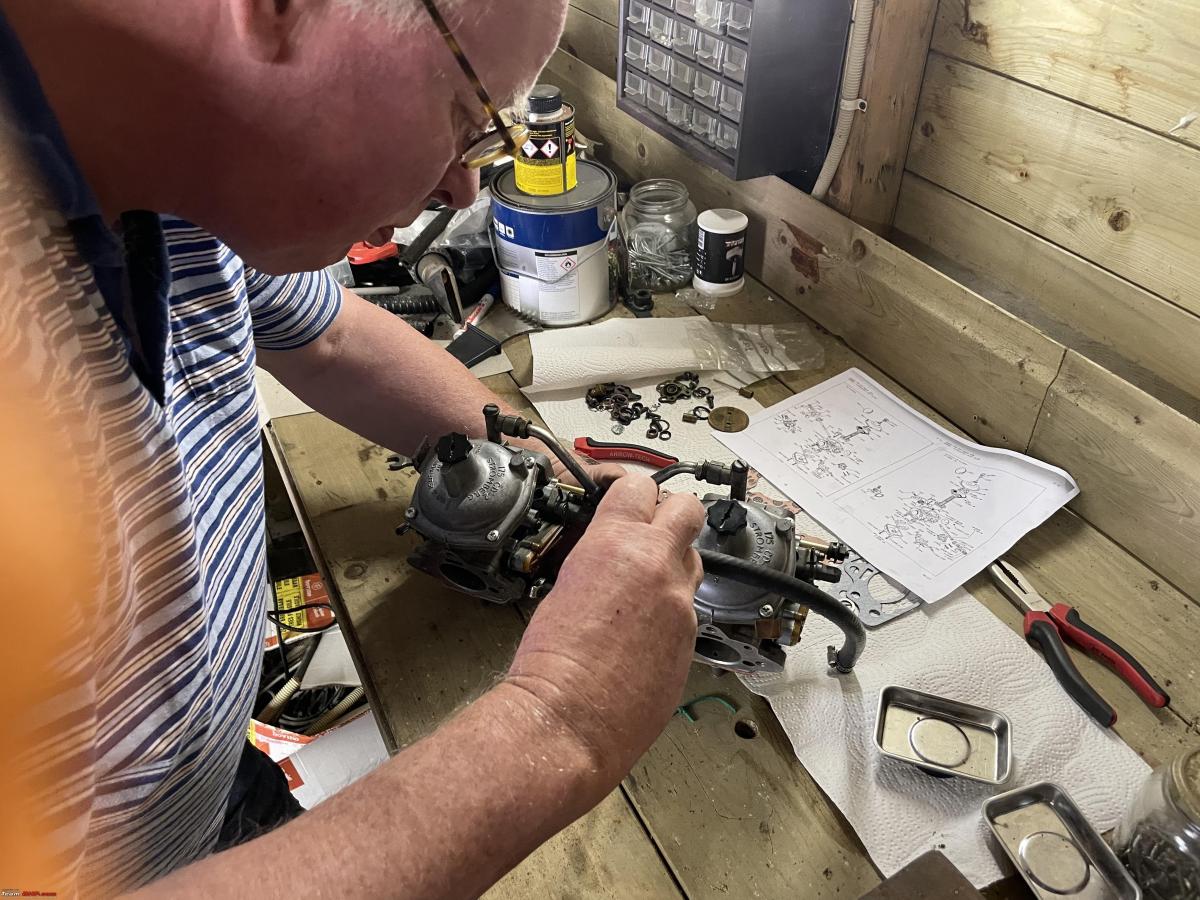
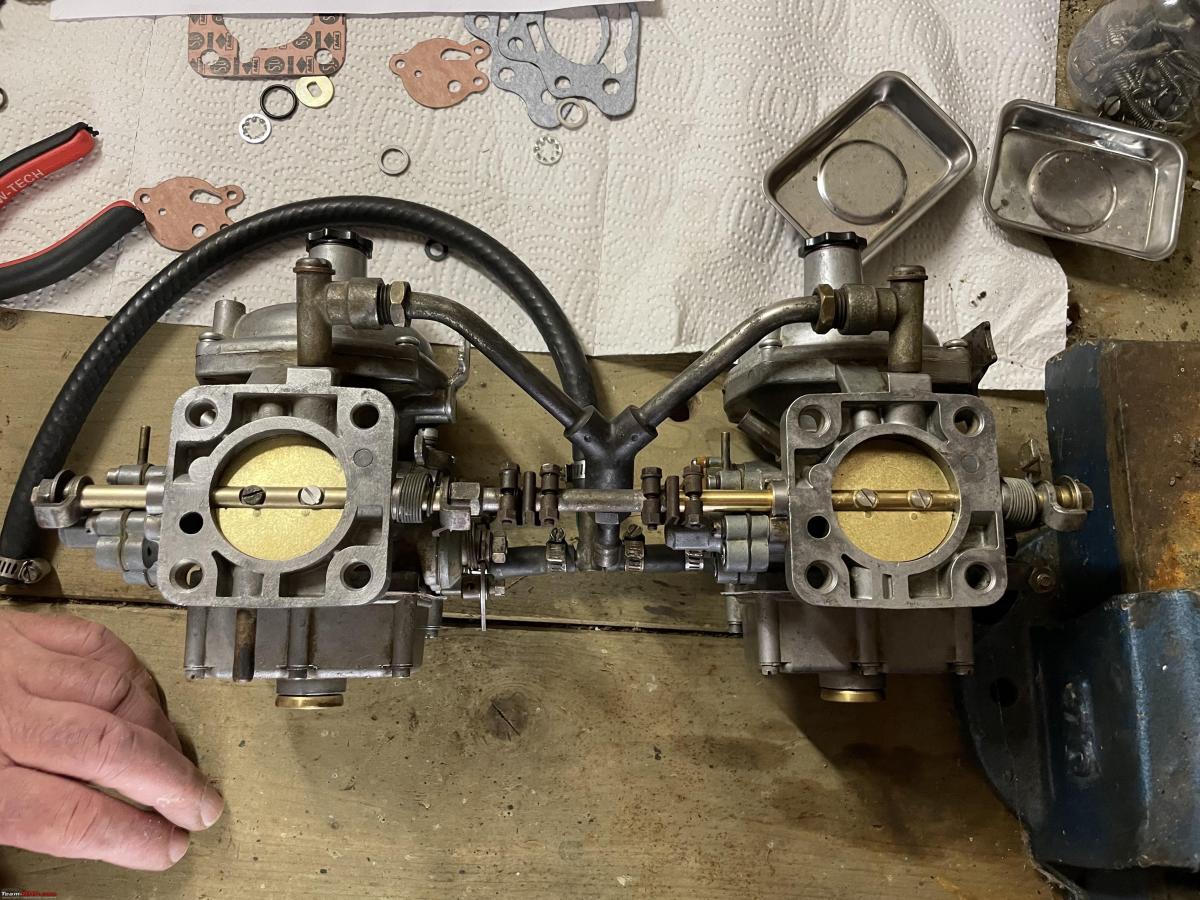
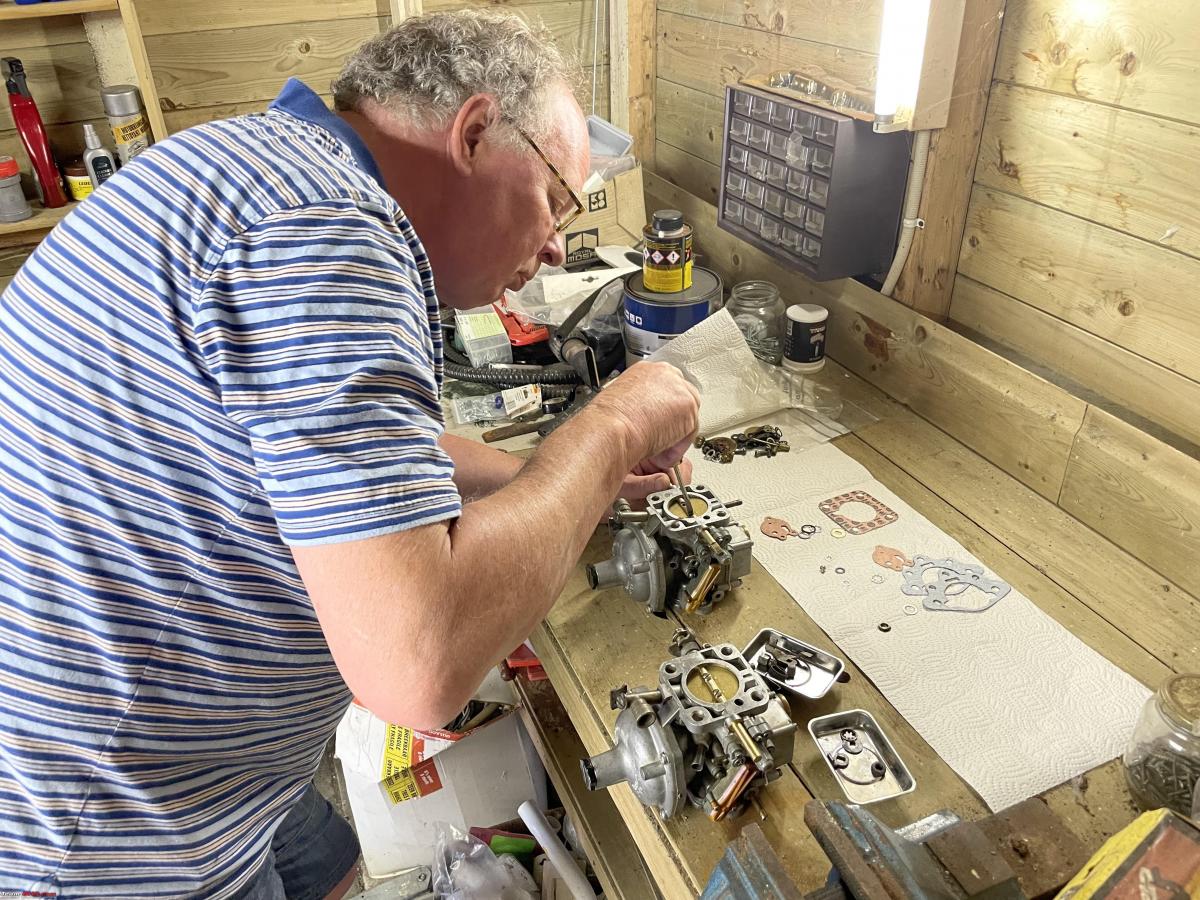
Putting the carburettors back on the engine was fiddly, but not difficult:
Before:
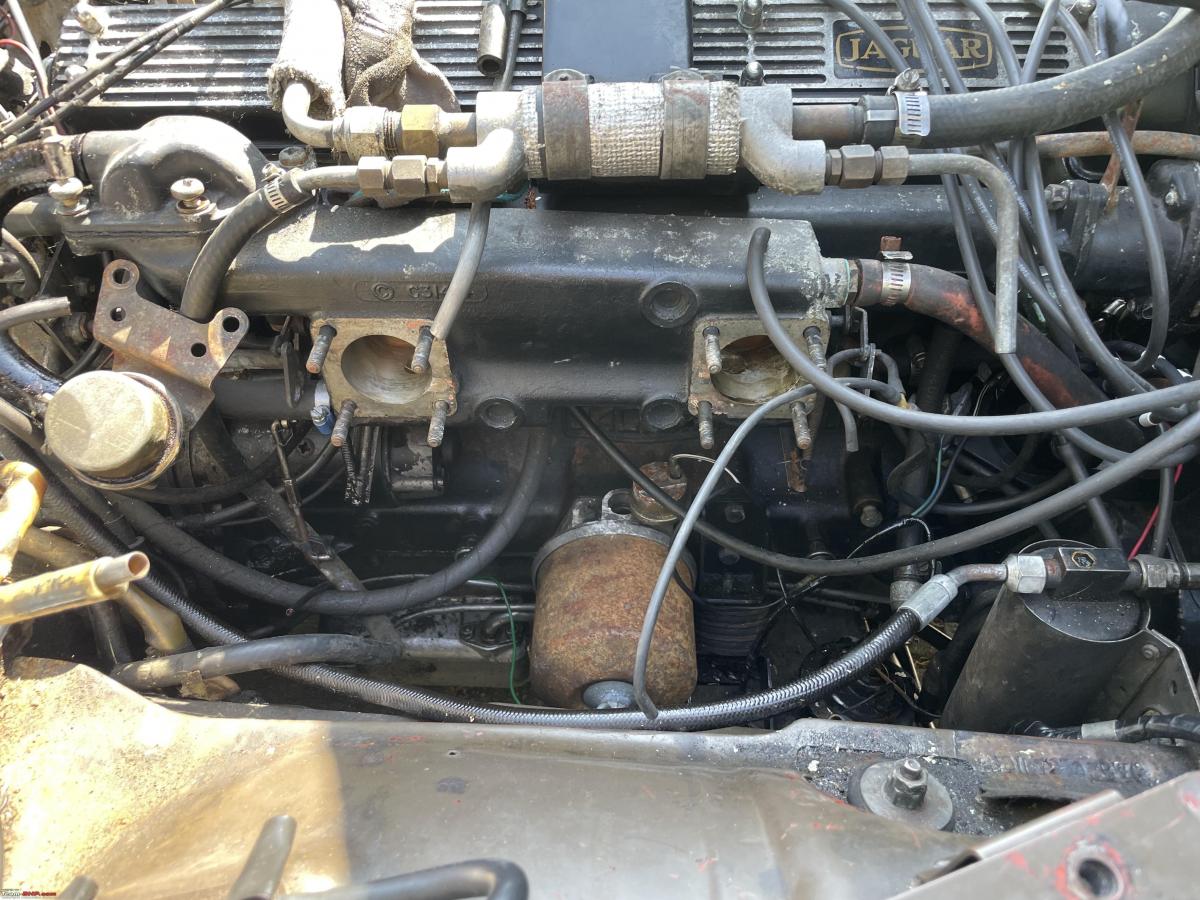
After:
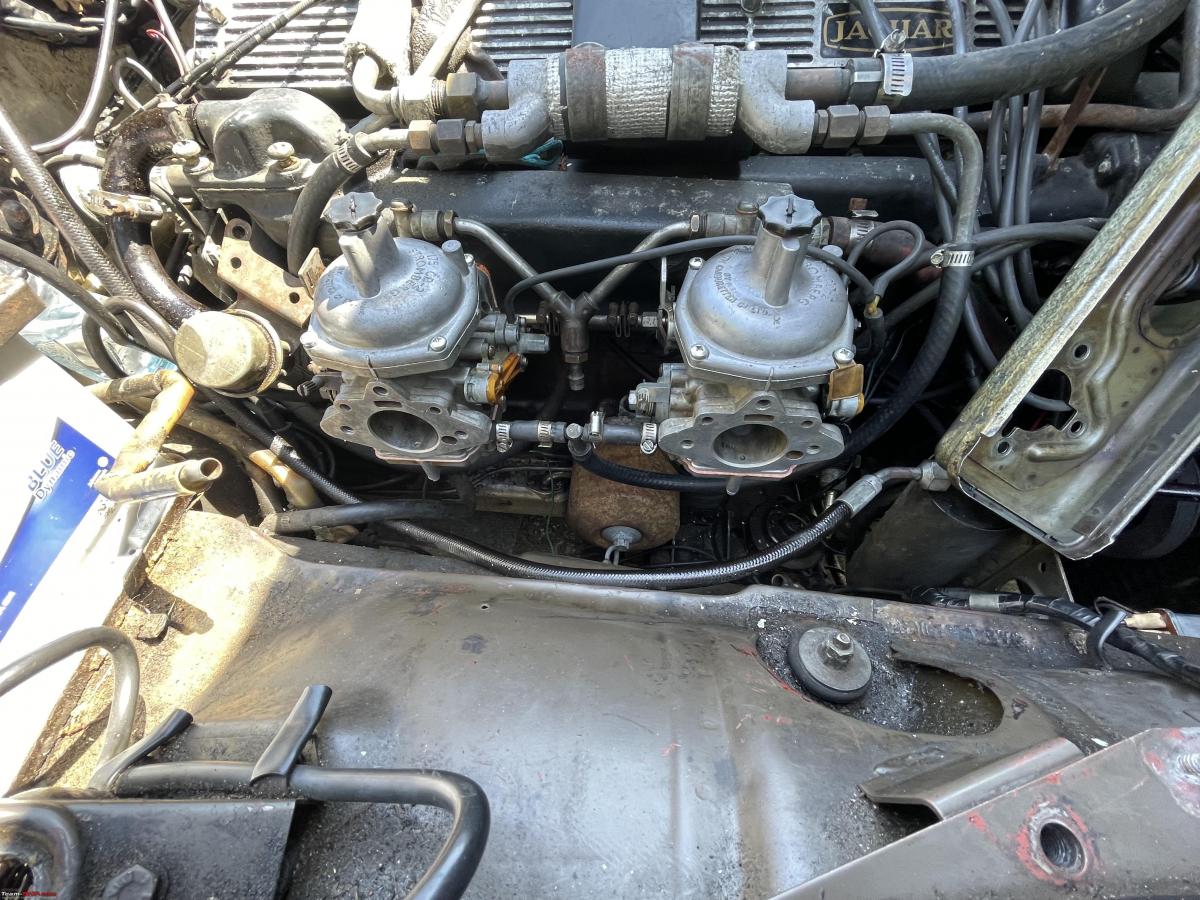
On purpose, we left off the air inlet filter and a bunch of other hoses related to the emission system. We just wanted to see if, after all this work, we would have fuel leak-free carburettors and whether the engine would start.
So with all the important and relevant bits tightened up, Peter turned on the ignition. We could hear the fuel pump starting up, which was good. But then fuel spewed out everywhere from the front carburettor. We took the cover of the float chamber off and I adjusted the float valve arm a tiny bit, which would ensure the fuel valves get closed properly in the up position. Worked well.
Attempt two and we were pretty sure this would work, so I rolled the video camera!
We were very pleased. After more than four years, we managed to bring this engine back to life. Obviously, we still need to do a lot more in terms of adjusting and fine-tuning. And that is before we start on the list of (many) other things still to be done on this car.
I had to leave early because our grandson Ben was coming to stay with us for the night. And I had promised to take him on a bicycle ride, go to the playground and eat ice cream. So we did!

Ben loves sitting in all my cars!!
Today Peter called. He had started up the Jaguar again. Drove it to the local petrol station. (Because one tank was empty and the other was half full with four-year-old petrol)
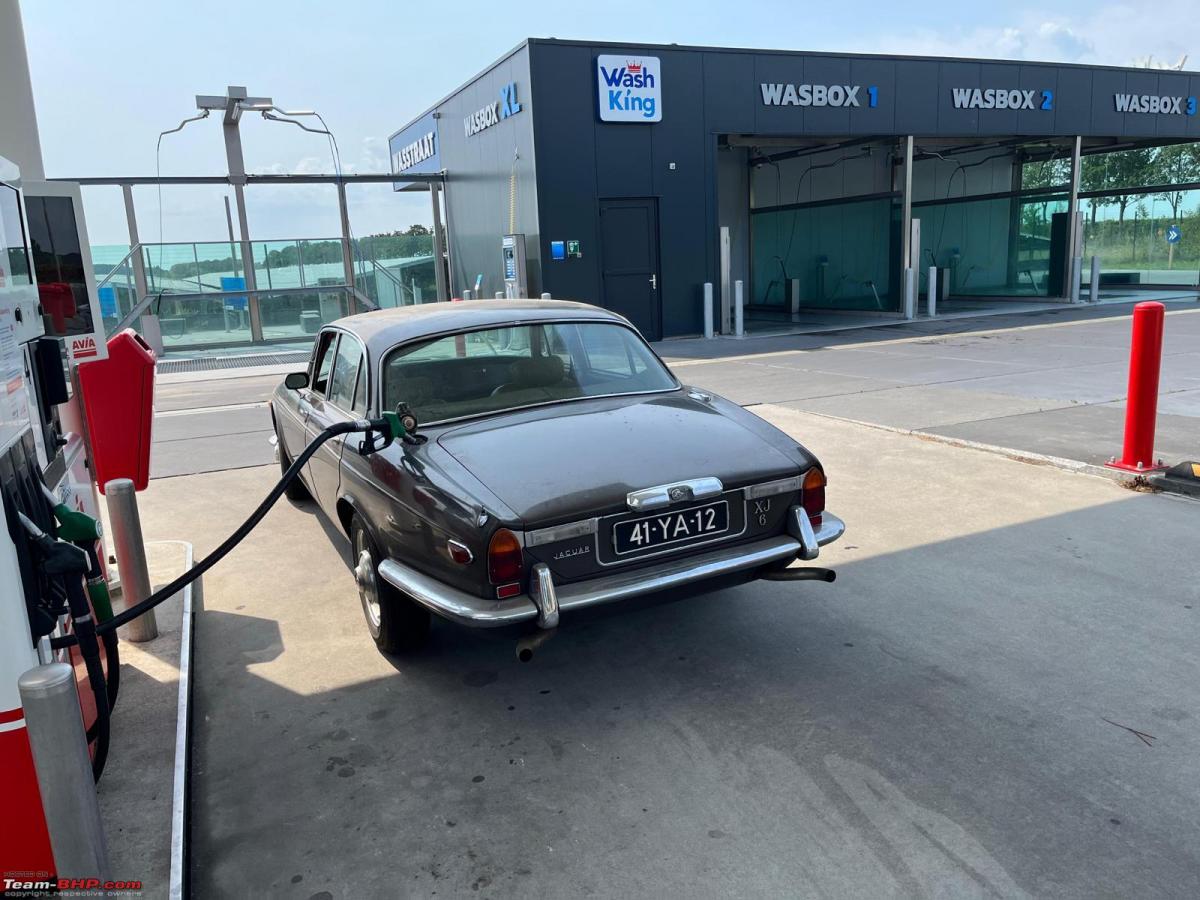
He also gave the Jag a quick wash, which was really needed.
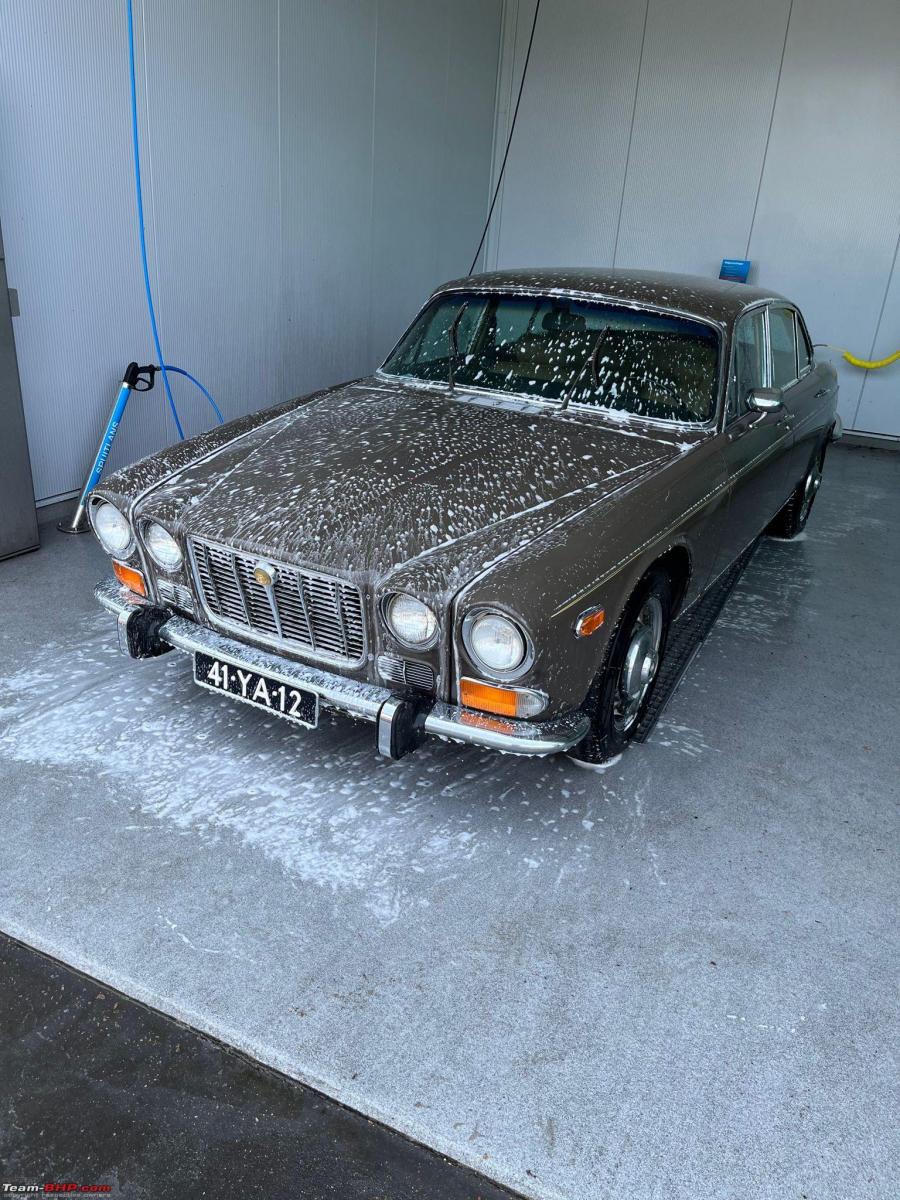
One small additional job though. During this first outing, there was a loud bang and the muffler exploded!! The engine is running very rich, so that can happen. A well, on the to-do-list!
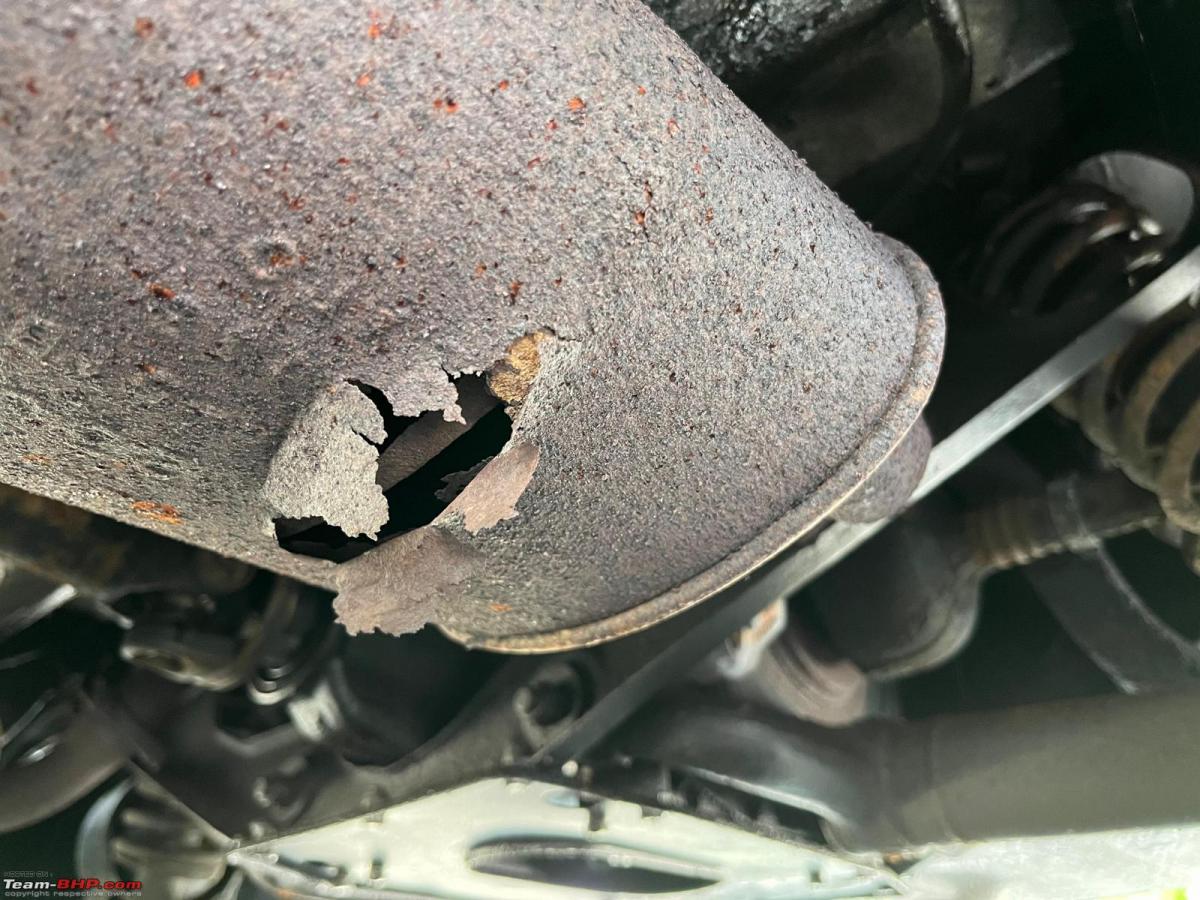
Anyway, very pleased to have this car running again. Still lots of work to be done on the engine and other bits.
This week I will probably pop over to my friend Berndt to work on his Austin Somerset (which won’t start) and his Mini ( which won’t honk!).
Still waiting for the clock spring for my Jeep. So I can fix the horn/airbag alar and cruise control which are all not working due to the broken spring, currently under the steering wheel.
Check out BHPian comments for more insights and information.
News
Bought a pre-owned Jaguar XKR V8 supercharged as my weekend car
Nothing could have prepared me for the amount of adrenaline rush I got when I floored her.
BHPian tin lizzie recently shared this with other enthusiasts.
Hi folks!
I am sorry for posting this a little late as I got the car 2 and a half months back. It's been busy for me on the work front.
Well here's the story. I went to Mumbai on 15th Apr as planned and went straight to my friend's office where he had brought the car.

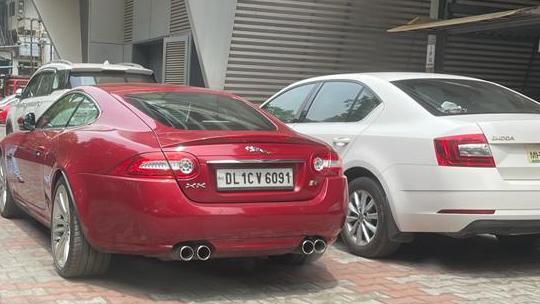
After grabbing a quick lunch with my friend and reminiscing old times at school we headed for what I was waiting for. The Drive.

As I got into the driver's seat, I was a bit nervous. But nothing could prepare me for the amount of adrenaline rush I got when I floored her. The acceleration was relentless, shoving me back with immense G forces. I had never driven anything like her before.
The handling was perfect, the steering weighing in as it should be and the Pirelli P Zeros holding on to the road like a leech.
I knew then and there that I HAVE TO HAVE HER. AND I WILL NEVER LET GO OF HER. I WILL MAINTAIN HER EVEN IF I HAVE TO SELL MY HOUSE, I WILL LEAVE HER FOR MY DAUGHTER IN MY WILL. (Such were my thoughts).
The car pulls and pulls and pulls, tugs at your heartstrings and makes you come alive. That's the power of a V8 with a supercharger, 500 horses always raring to go with a push of your right foot.
I thought this was the best-sounding V8 I had heard in real life.
I have been big time into video games, be it Atari, Game Boy, PS3, PS4, and now PS5 with the latest game being Mad Max. I was subconsciously comparing the sound of Max's Interceptor (V8) with this Jaguar V8 and boy I was absolutely spellbound. It was the most exciting drive of my life.
After the drive, we popped the hood and there it was. The supercharged Jaguar V8.

As advised by Turbanator, Jeroen, androdev, I got the folks at Navnit Jaguar to do a full check-up of the vehicle.
Before embarking on my journey I had made a full discussion with them about the car as it had been regularly coming to them for service and routine maintenance. A full paid check up was done, which took 2 days (including the work required and change of oils plus routine service).
My friend provided me with a full service history along with the work he had got done over his ownership period.
The Findings
By Owner
- One incident of rims being bent and being replaced along with sagging of the Alcantara roof liner, replaced at Jaguar itself. Rear suspension work done.
By Navnit Jaguar Mumbai
- ODO 18500 km
- Regularly serviced.
- Battery 5 years old - replaced.
- Suspension rear - no work required.
- Front - upper control arm bush needs changing - pending arrival.
- Wiper blades changed.
- Vacuum Pump oil leak - changed the seal.
- Supercharger serpentine belt changed (recommended at 10 years by Jaguar).
- Belt drive changed (also recommended).
- Engine oil changed.
- Particulate air filter changed.
- Antifreeze changed.
- Rear Diff oil changed.
- Transmission mount changed.
- Air & oil filters changed.
The checkup did not reveal anything which would deter me from getting her.
Some pics while at Navnit Jaguar:



Post maintenance:

Post all this, my friend offered to drive the car to Lucknow. I was slightly worried owing to the low ground clearance (120 mm) and the long distance. A flat bed covered carrier was booked and the matter was done and dusted.
@Jeroen. Sir, you gave me the best advice about joining the Jaguar forum. I joined it and learned a lot about the Jaguar XKR.
Points - earlier generations (before 2011) were having 3 main issues:
- Timing chain tensioners.
- Water pump failures.
- Thermostat wear & tear causing it to be stuck in open or closed position.
All of these occur after a certain age of the vehicle.
There is a coolant pipe that runs through the valley of the V8 that eventually gets cooked up after 10 years and needs to be replaced.
The AC drain-tube at the passenger side can get clogged and is a difficult place to reach.
Most of these problems have been reported less after 2011 models as the niggles were corrected by Jaguar.
@Turbantor. You are absolutely right about JLR, there is a definite element of unreliability that is part n parcel of Jaguar ownership. The Jaguar forum showed me all that is to Jaguar ownership, the passion, the niggles.
This became my weekend car or hobby car. I have the Endeavour 2017, and the i10 AT 2011 as my beater cars.
I know it's gonna be interesting ownership. In these 2 months of ownership, I've driven her every alternate day and boy she does make my boyhood come back. The sound of the V8 coupled with the addicting acceleration makes every drive a special one.
One omission by Jaguar on the XKR that hurts the most is the absence of a temperature gauge. I got myself an OBD Scan Gauge after advice from the Jag forum members. It monitors the battery voltage and the coolant temperature because these cars do run hot at almost 195 to 212 F. That's their normal operating temperature.
Coolant has to be checked religiously every week for she's an old girl and might throw a temper.
Am prepared to change suspension bushings/parts, coolant pipes, thermostat, water pump as and when the need will arise.
Some pics from when she reached home:


Check out BHPian comments for more insights and information.
News
Gear shifter failure on my Jaguar XE: Got a repair estimate of 1.5 lakh
Since this is a known defect with Jaguar cars it should be replaced free of cost which has also created a lot of inconvenience for us.
Thanks to Bijal Shah for sending this in. Heartfelt gratitude for sharing it with other enthusiasts via this Team-BHP share page!
We have been loyal customers of Jaguar and have been using the Jaguar XE since 2017 with Registration Number - MH01CP8796; which has run approximately 25,000 km however we are unhappy with the issue resolution we have received.
On 14th March 2023, the car gave a sudden issue where the gear was not shifting to 'Drive' mode. We had to immediately move the car late at night (3.00 am) via Roadside Assistance to the service centre as the car was not moving. Upon further inspection, it was observed that the gearbox was not in Park Message on IPK, with the gear shifter also needing to be replaced.
We know that the failure of the gear shifter is not a wear and tear issue and is a manufacturing defect. Even found out that this is a global issue.
We request you to kindly arrange replacing the gear shifter free of cost, since it is a known issue and is happening regularly with Jaguar users.
Attached is a copy of the estimate received from the service centre for your ready reference and kind perusal.
Since this is a known defect with Jaguar cars this should be replaced free of cost which has also created a lot of inconvenience for us.
Looking forward to hearing from you in this regard at the earliest.
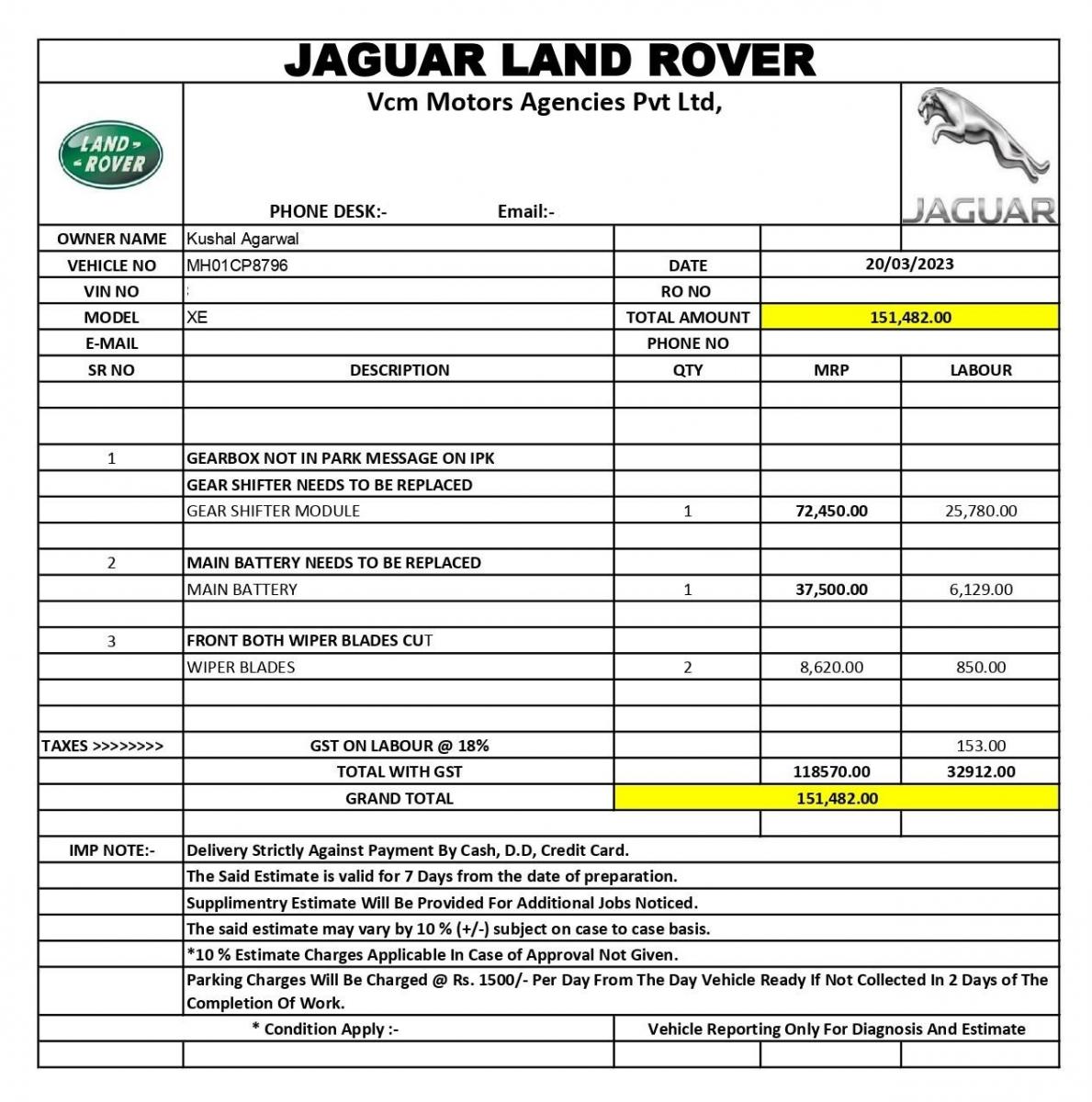
Here's what BHPian udzgodfather had to say about the matter:
It's sad to see that even after paying such premiums for luxury cars, a customer has to suffer so much on the dealer's end.
J&LR are known for their breakdowns and poor services in India, I know a lot of J&LR customers who are not happy with the dealer service network. It is sad to see that they are not doing anything about it, I hope the management takes cognizance and resolves the issue at the earliest.
May this just be a bump in your ownership experience and you have many more happy miles on your beautiful machine.
Here's what BHPian Turbanator had to say about the matter:
Yes, JLR is renowned for bad cars and most buyers are aware of this, but the car is out of warranty. Given the low mileage and if this issue is known, JLR can offer some or a complete goodwill rebate but I won't fault the dealer just because they are asking money for repairs. Battery and wipers are wear & tear parts so those won't qualify for any goodwill rebate.
But since the battery is bad, should the dealer not see if by any chance this whole fault is due to the battery? If they have already checked, then I am afraid, the customer has to ask the dealer to take up with the manufacturer for any support. It will be the prerogative of the manufacturer to pass any such benefits or not.
Here's what BHPian Jeroen had to say about the matter:
One would hope the Jaguar mechanic did a good job diagnosing this problem. But statistics say it is more likely to be a different problem or at least one that could be solved for far less.
Jaguars are known for being very finicky towards a good battery. Ask me how I know. Without a good battery, all sorts of odd problems could materialise.
So without a new battery, it would be difficult to draw any final conclusion. A Jaguar with a poor battery just spews out error codes and starts doing all sorts of crazy stuff.
Coming to this particular issue, yes it is a known issue.
The most common causes are, in no particular order:
- Shift lock solenoid - the shift lock mechanism stops the driver from being able to take the vehicle out of park when the engine is off. It also stops the driver from being able to select a gear without depressing the brake pedal and the ignition on.
- Ignition barrel - If the ignition barrel is faulty it can cause the transmission to get stuck in park.
- Faulty shifter mechanism - If the shifter or the shift bushes are worn it can make the transmission hard to shift into gear.
- Faulty shifter cable - If your shifter cable is damaged or worn it can cause issues trying to get into gear.
- Failing transmission - Internal failures inside the transmission such as valves or torque convertor issues could also stop the transmission from shifting properly.
Every single one of them, except the last one, has an easy fix. However, Jaguar dealers often won't go that way and will just replace complete (expensive) assemblies.
My own experience with Jaguar TDC faults is that 95% of them tend to be related to poor battery, poor electrical connection or ground. This means most faults are easily fixed by a new battery and thorough cleaning of battery terminals, fuses, electrical connectors and ground straps.
I am not saying this is the case here. We simply do not know. However, as they believe the battery needs replacing is almost a giveaway. With a poor battery and some dirt/corrosion on various contact, you get these sorts of problems. A new battery alone might solve the problem as it will provide a higher voltage, but the real problem might just be some dirt on a few electrical contacts.
Good luck
Check out BHPian comments for more insights and information.
Pages




